


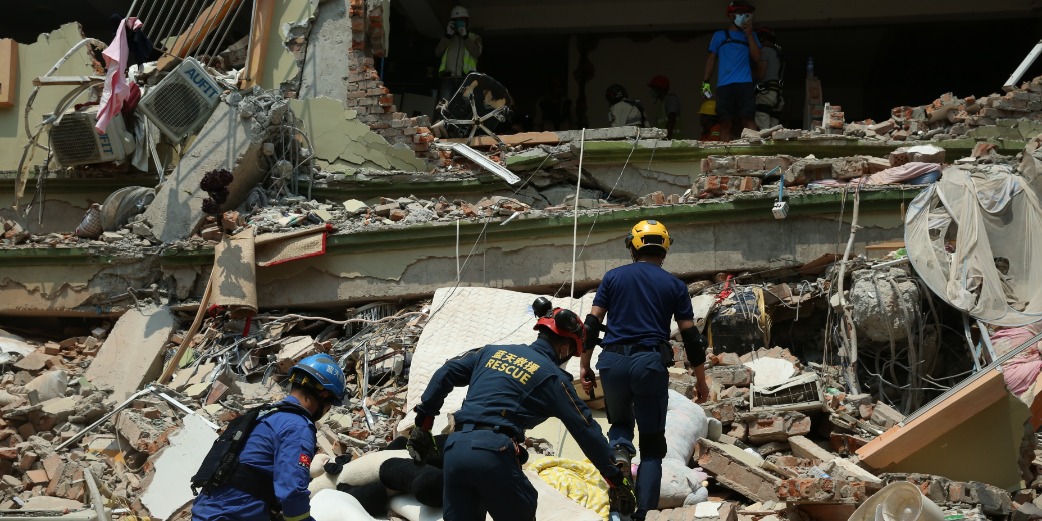
The death toll has risen to 3,145, with 4,589 injured and 221 still missing.
4 Chinese citizens dead, 13 injured in the earthquake.
BEIJING -- The first batch of aid supplies from the Red Cross Society of China (RCSC) arrived in Mandalay, the epicenter of Myanmar's recent 7.9-magnitude earthquake, on Wednesday, according to the RCSC.
The supplies include over 4,900 relief items such as tents, blankets, folding beds, and family kits to support the affected households. The Myanmar Red Cross will distribute these items with assistance from an RCSC rescue team, which had previously entered Myanmar and is also helping set up shelters.
Following the deadly quake on March 28, the RCSC promptly donated 1.5 million yuan (about $208,900) in emergency funding. At the request of Myanmar, the RCSC dispatched relief supplies to the disaster-stricken area and deployed a rescue team to the epicenter to conduct humanitarian operations.
Currently, 15 RCSC rescuers in Mandalay are conducting search-and-rescue operations, providing medical assistance and psychological support to those in need.
Hundreds of professionally trained Chinese volunteers have arrived in Mandalay to participate in the rescue efforts, after a 7.9 magnitude earthquake struck Myanmar on March 28. They are racing against time to save lives despite facing numerous obstacles, including local high temperatures that reach up to 40 C during the day. Follow China Daily for the latest updates of the Myanmar earthquake relief.
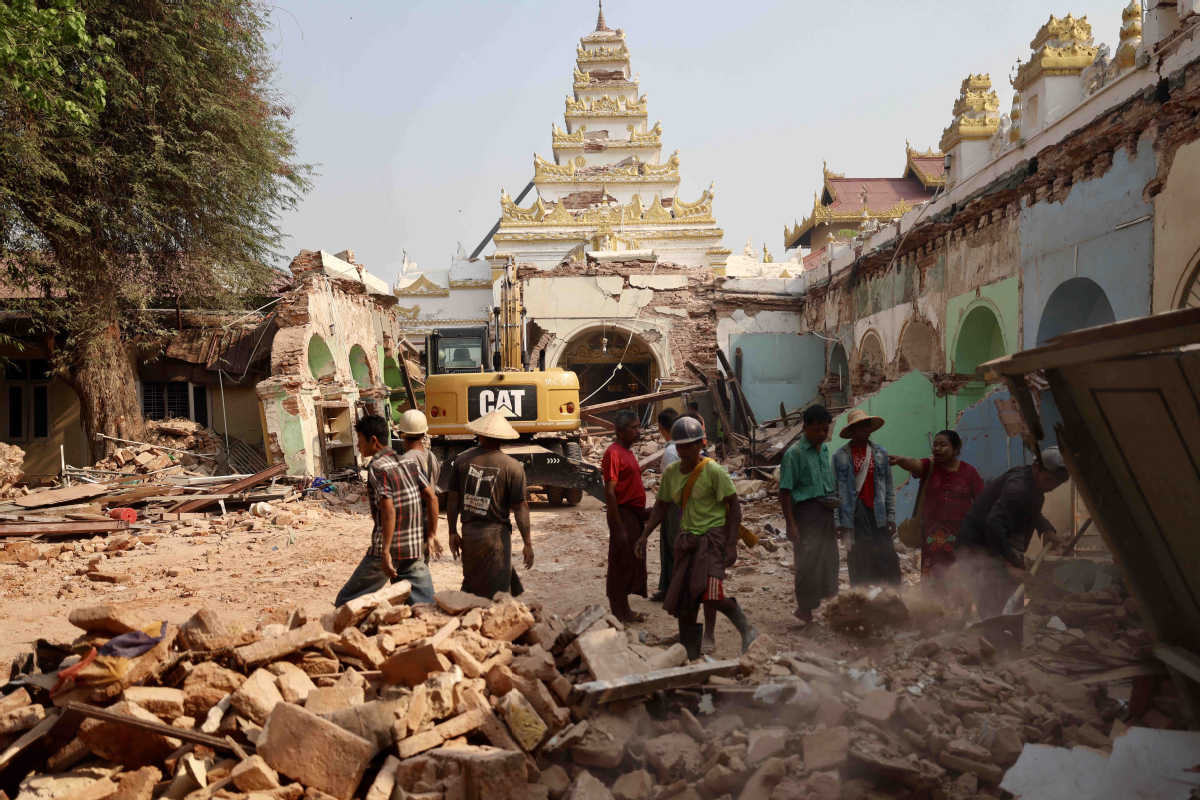
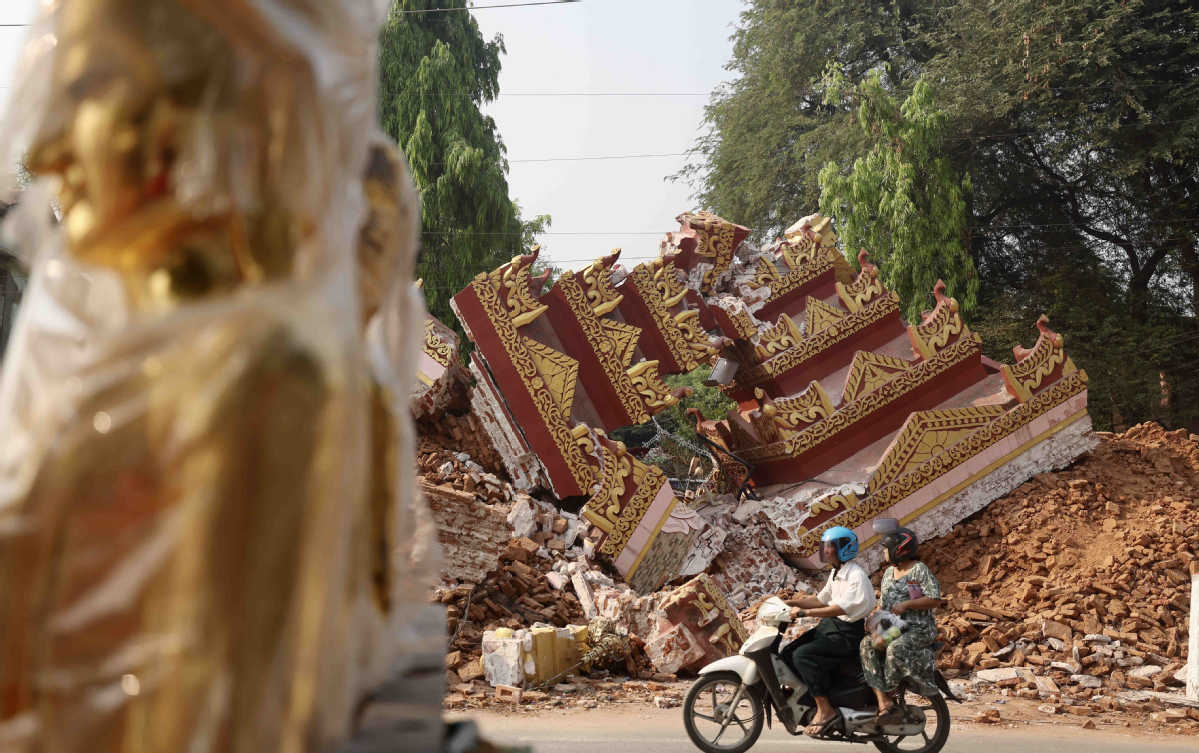
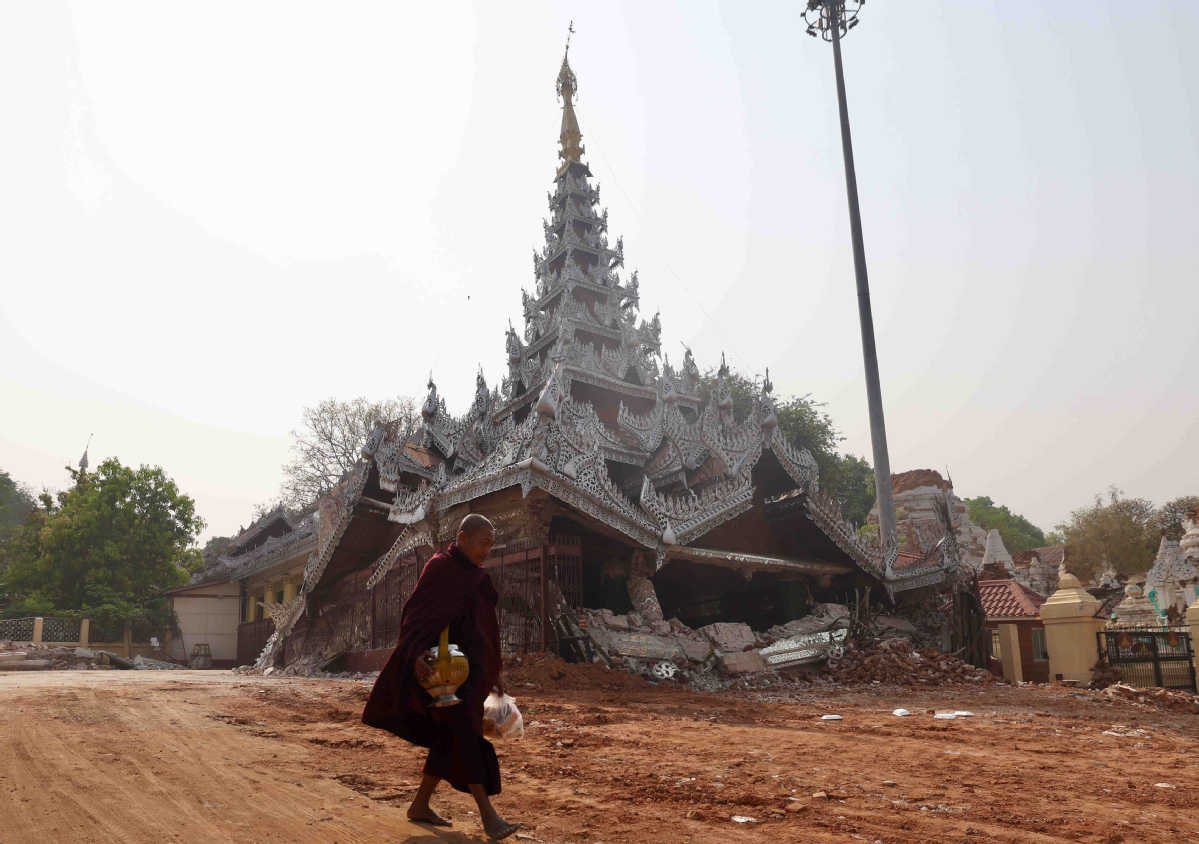
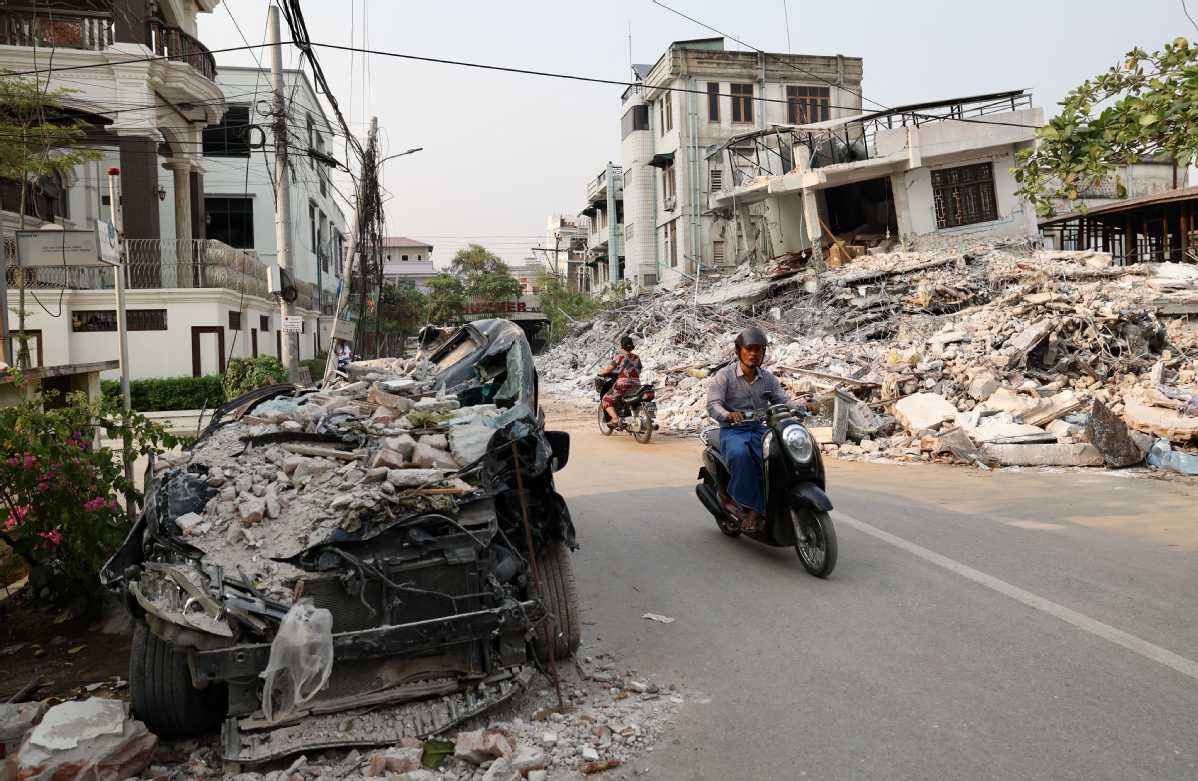
YANGON -- The death toll from Friday's 7.9-magnitude earthquake in Myanmar has risen to 2,886, with 4,639 injured and 373 still missing, according to the State Administration Council information team on Wednesday.
Myo Nyunt, president of the Myanmar Red Cross Society, told Xinhua earlier that key challenges in the current rescue operations included disaster assessment and logistics coordination.
Due to safety concerns in the affected areas, rescue teams have faced significant difficulties in distributing supplies, with a particular shortage of heavy machinery, Myo Nyunt said.
YANGON -- The Chinese Embassy in Myanmar has delivered cash assistance worth 1.5 million yuan ($206,700) to the Myanmar Red Cross Society.
Minister Counselor Cao Jing met here on Tuesday with Myo Nyunt, president of the Myanmar Red Cross Society, and handed over the cash aid offered by the Red Cross Society of China.
Cao said that China expresses sincere condolences to the Myanmar government and people for the casualties and property losses caused by Friday's 7.9-magnitude earthquake.
The Chinese government has decided to provide 100 million yuan of emergency humanitarian earthquake relief assistance to Myanmar, as numerous Chinese rescue teams have been working in the quake-affected areas, according to Cao.
"The assistance from the Red Cross Society of China once again demonstrates the profound friendship of the Chinese people towards the Myanmar people," Cao noted.
Myo Nyunt thanked the Chinese side for coming to the aid immediately and extending a helping hand to the Myanmar people.
The Myanmar Red Cross Society is willing to make joint efforts with China to overcome difficulties and rebuild its homeland as soon as possible, said Myo Nyunt. (1 yuan equals 0.14 US dollars)
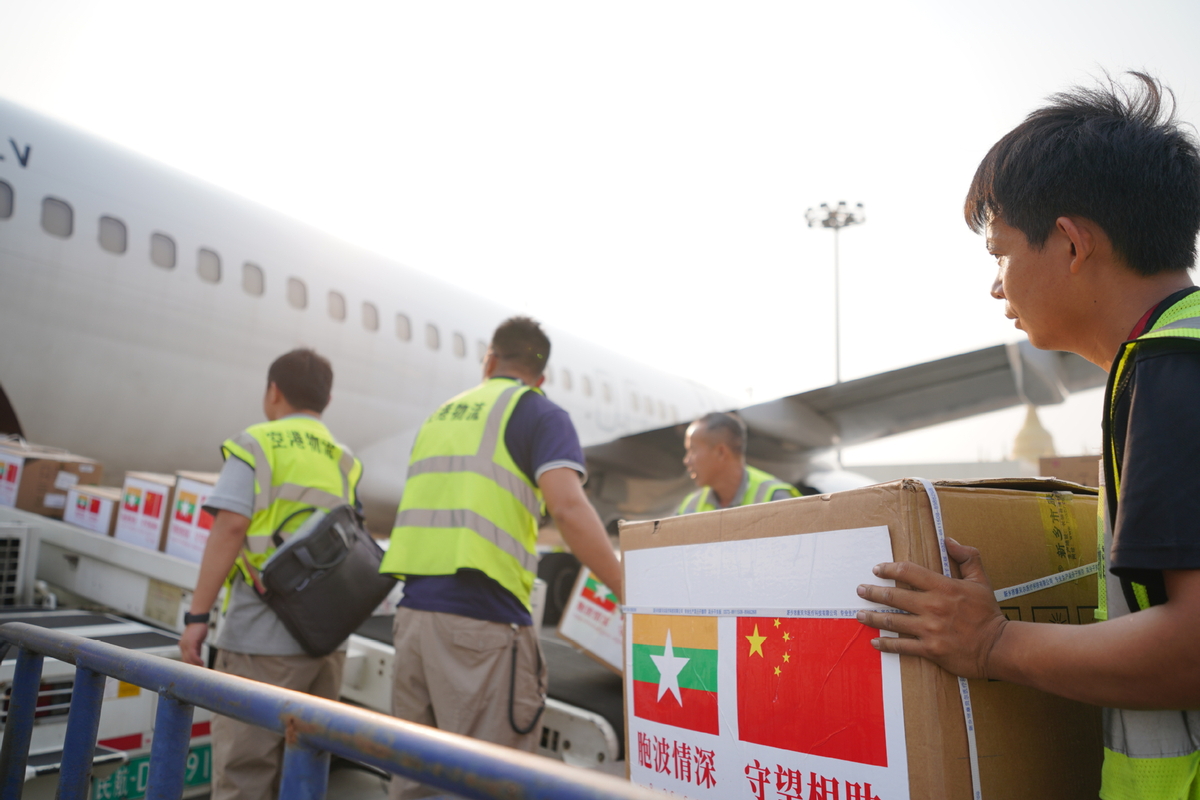
The Dehong Dai and Jingpo autonomous prefecture in Southwest China's Yunnan province donated a batch of medical supplies worth more than 240,000 yuan (around $33,011.76) on Tuesday to support earthquake relief work in Myanmar.
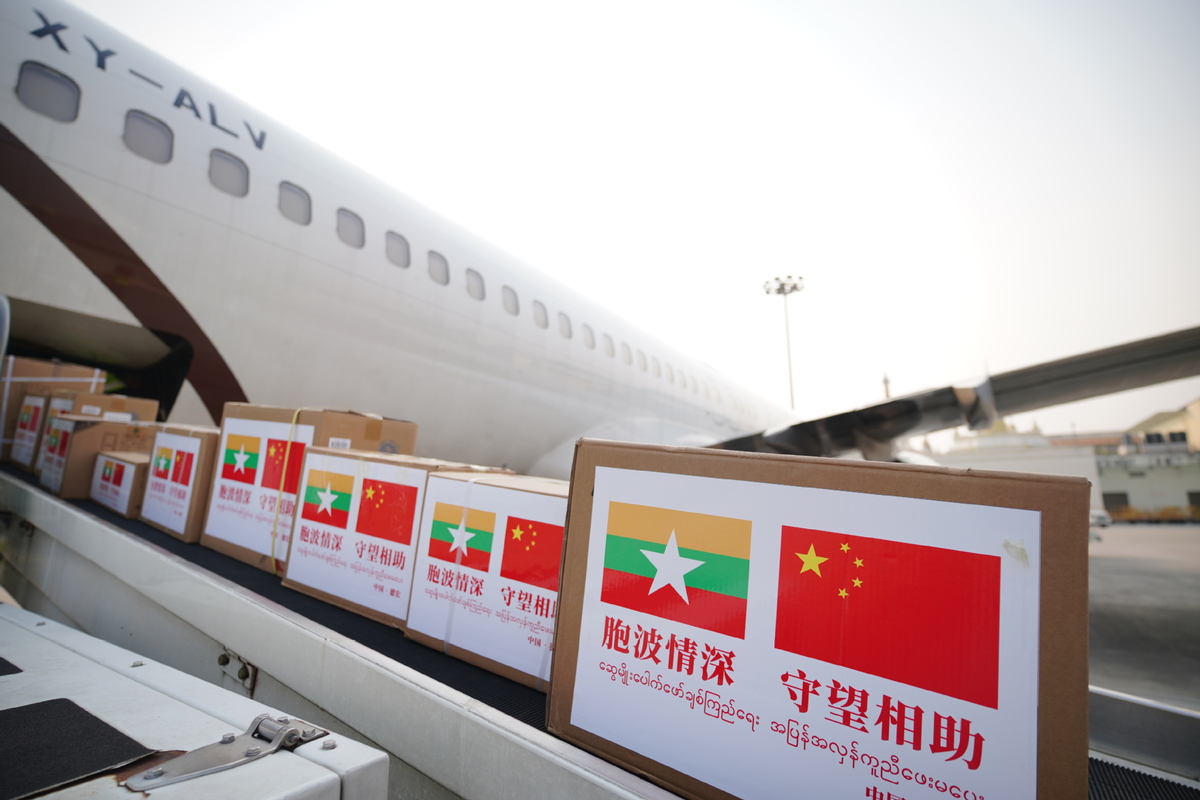

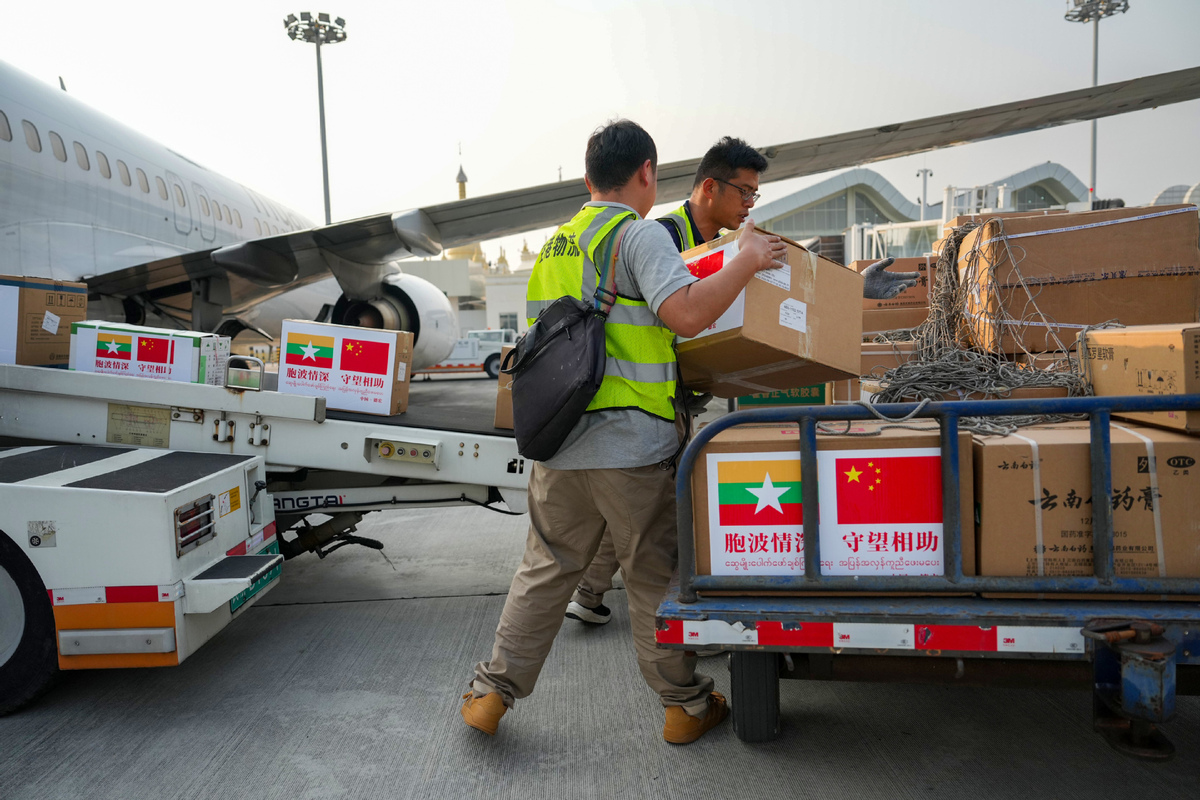
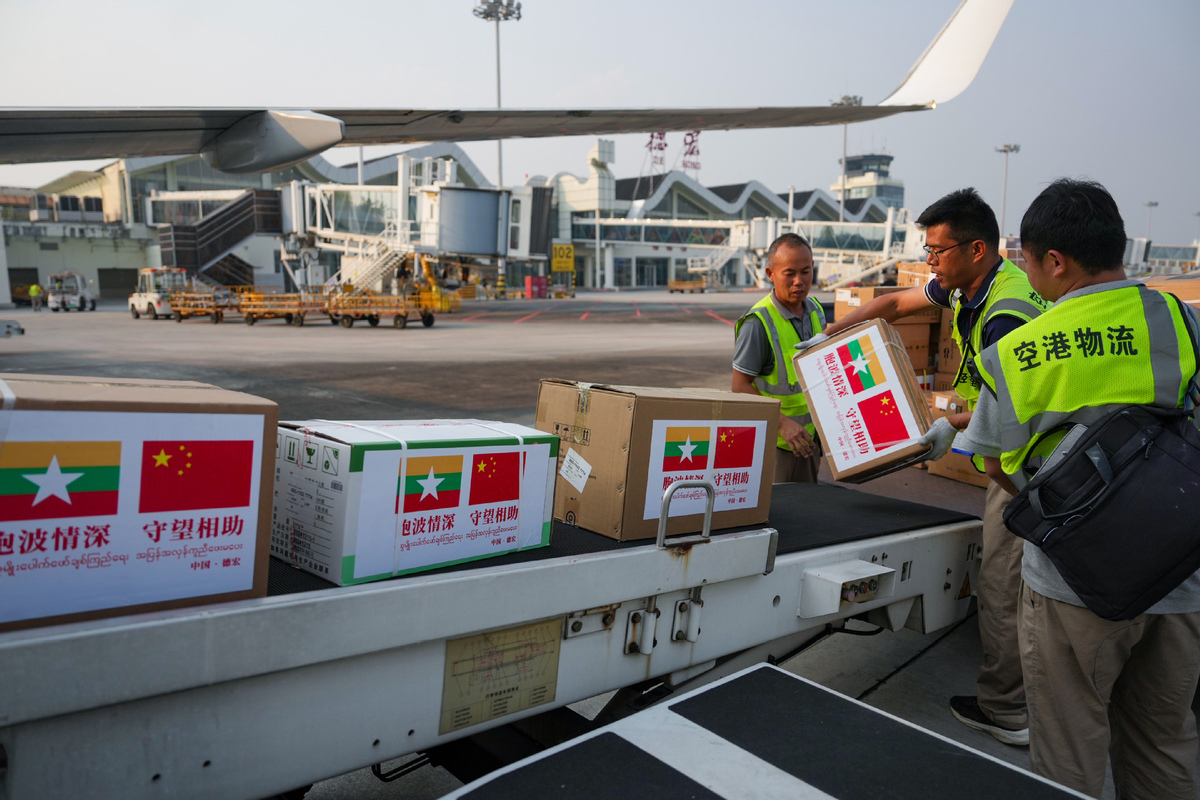
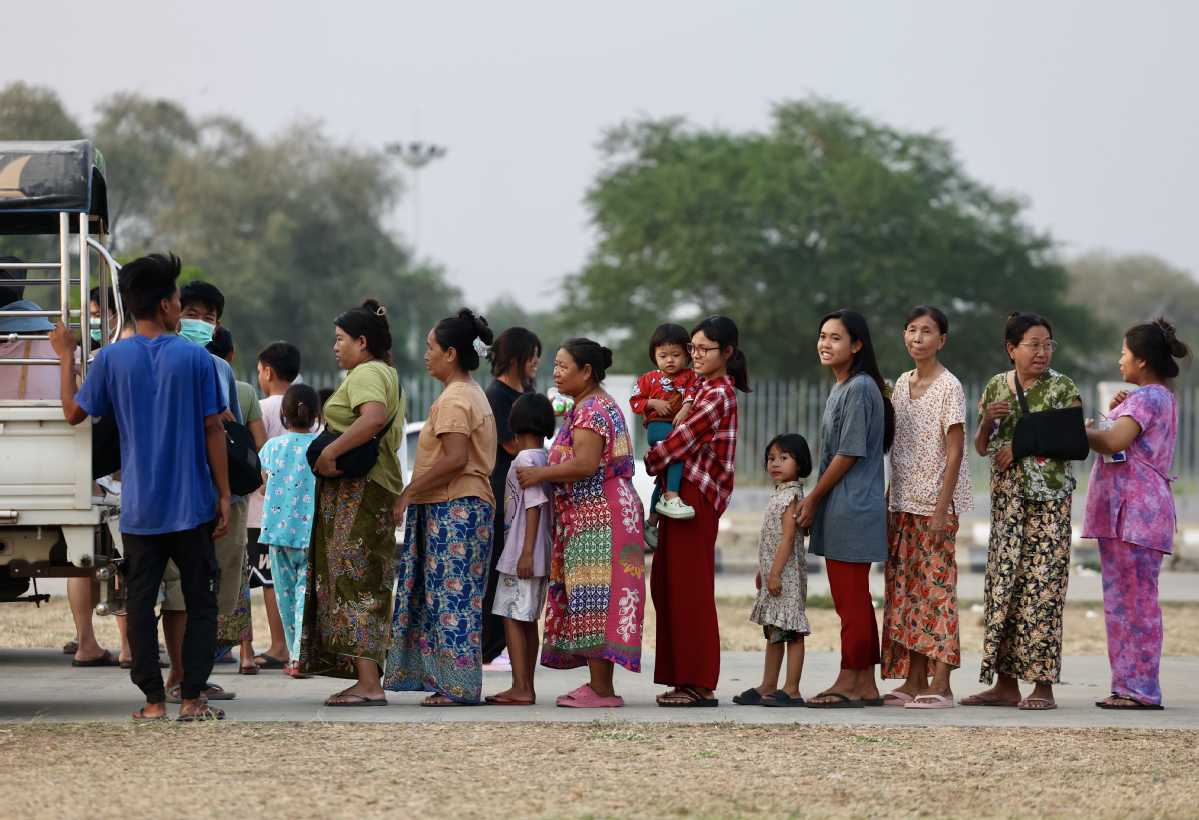
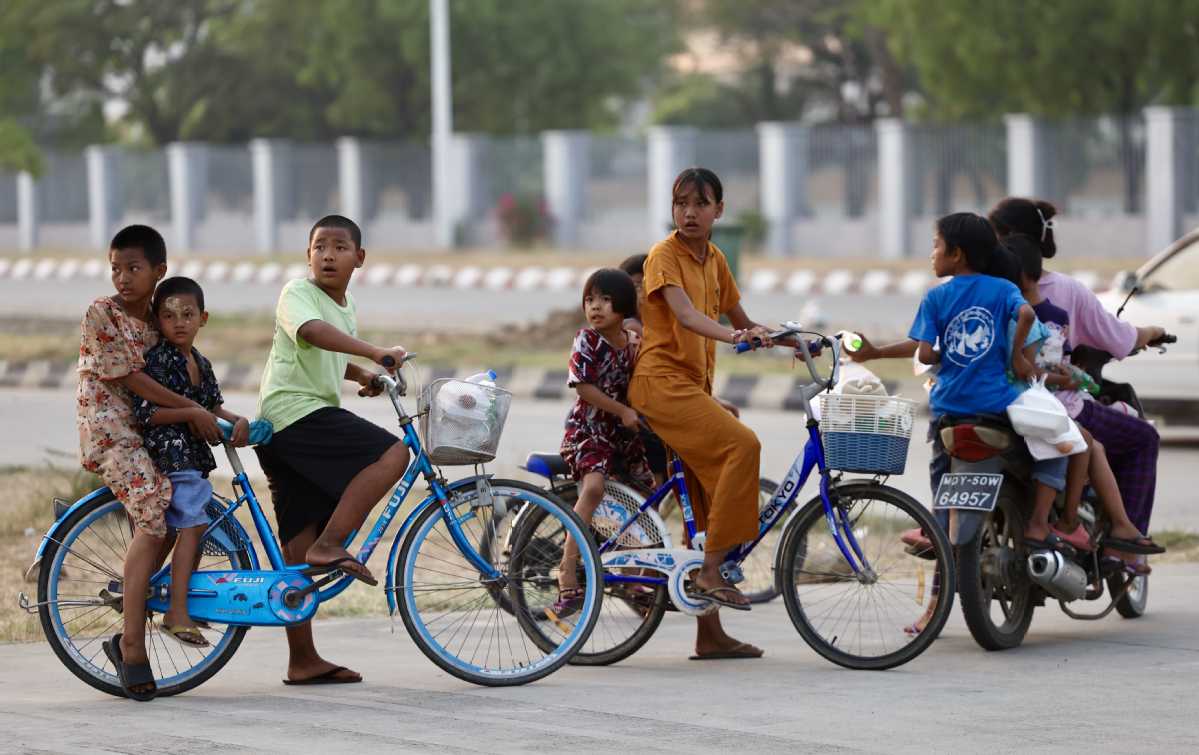

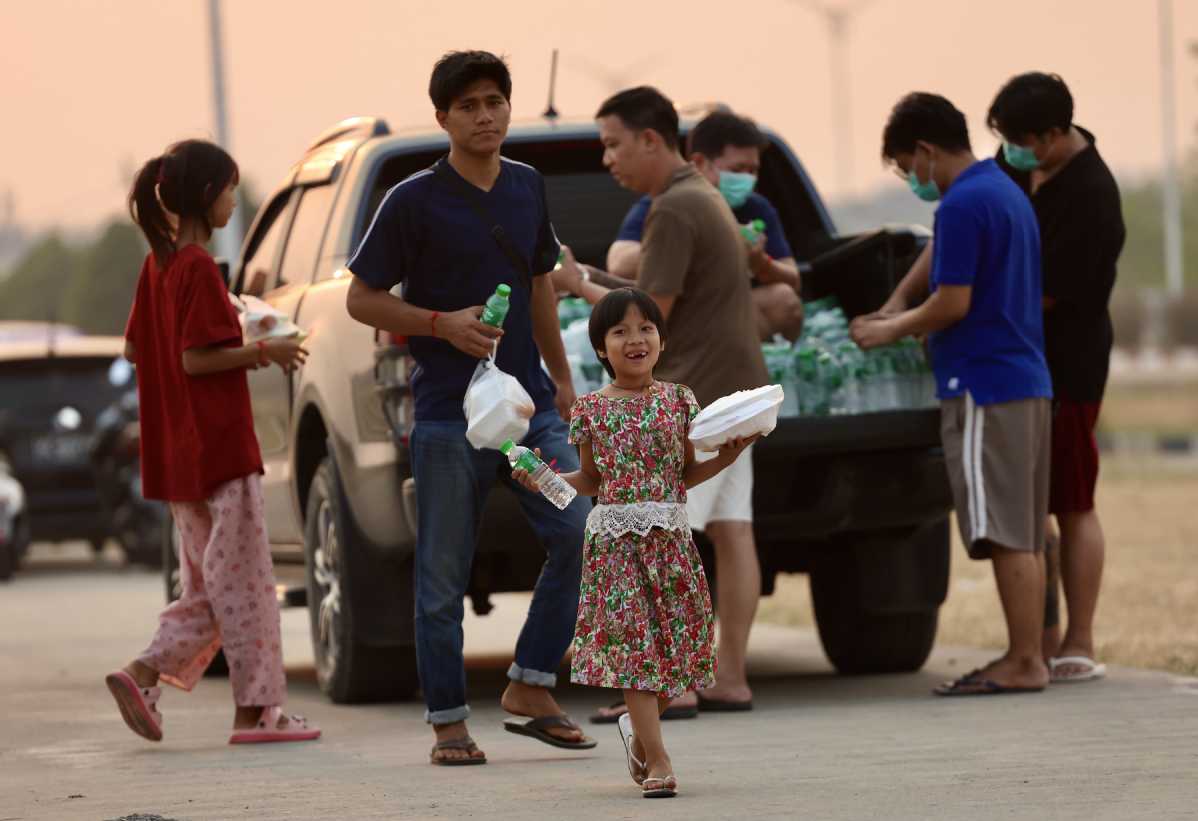
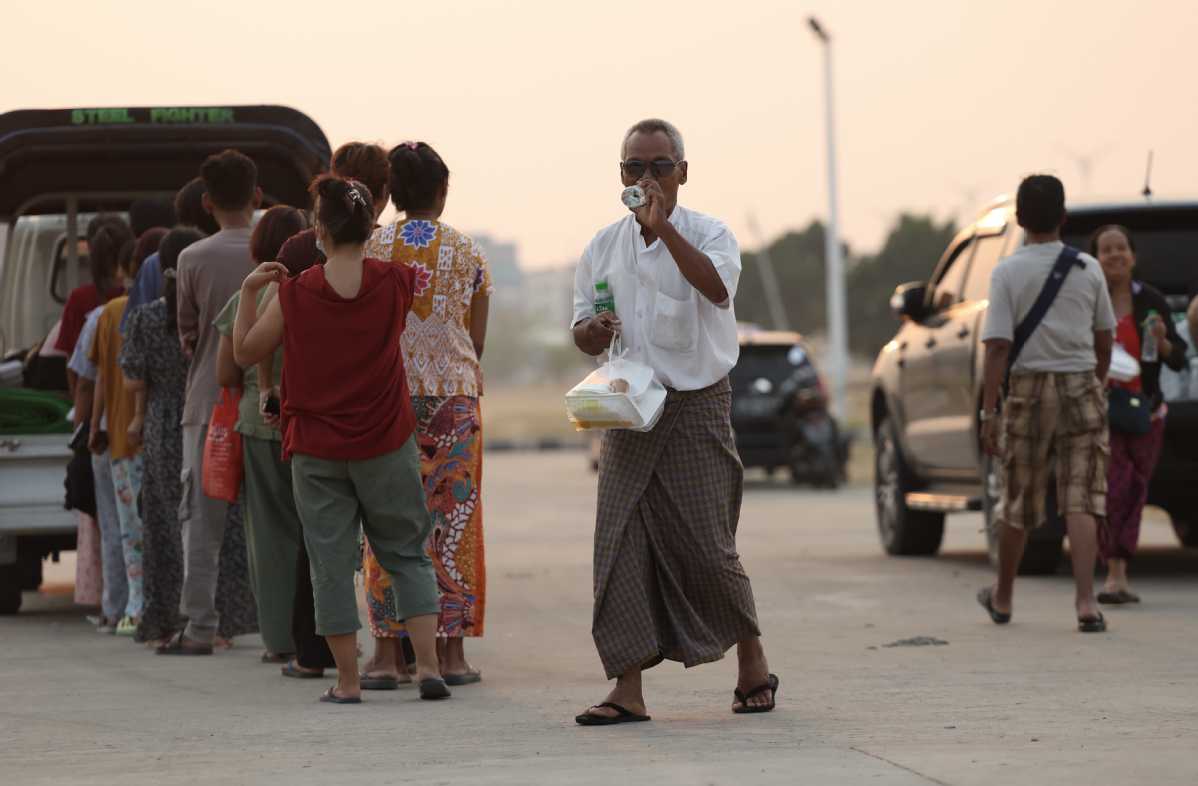
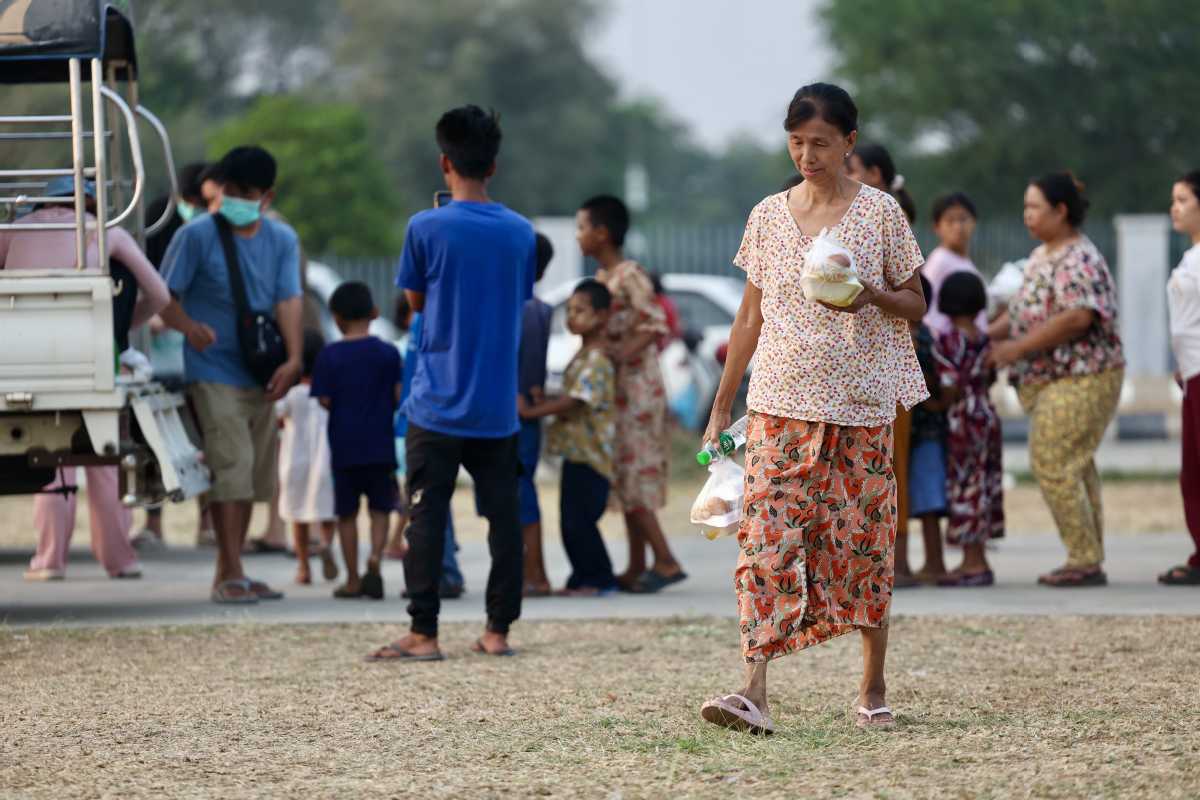
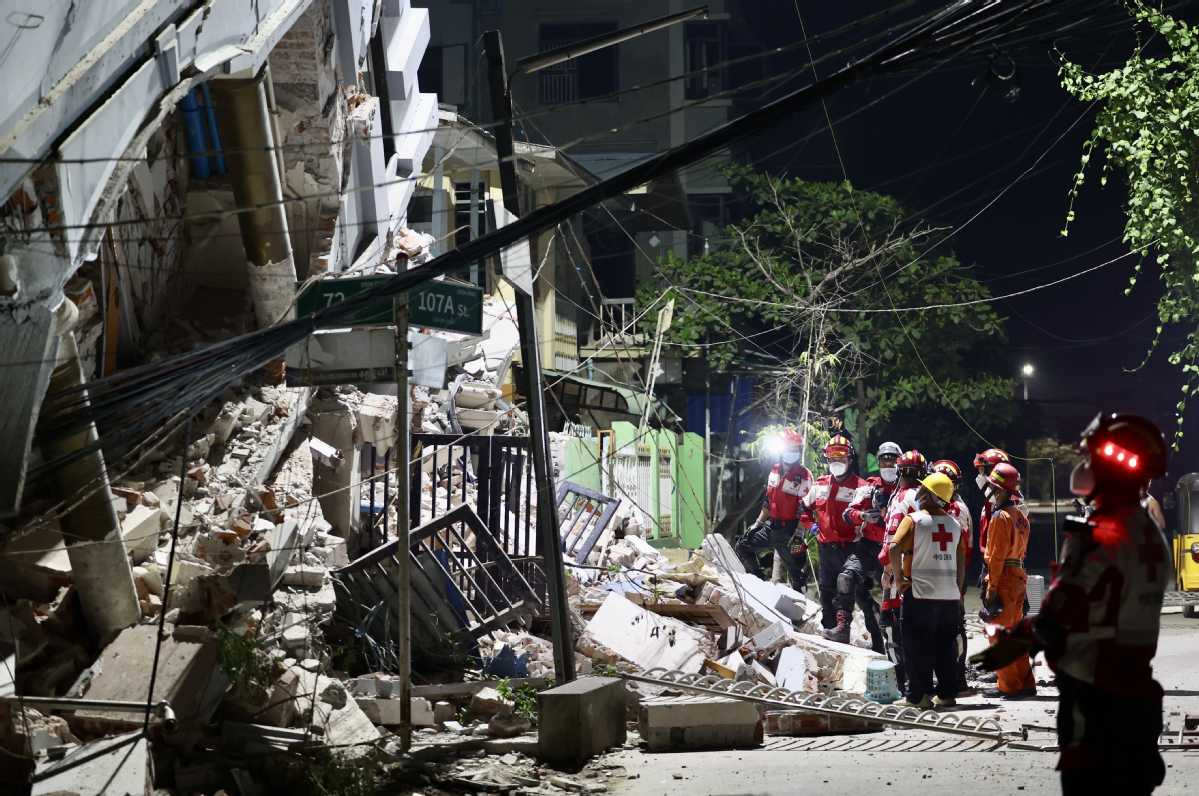


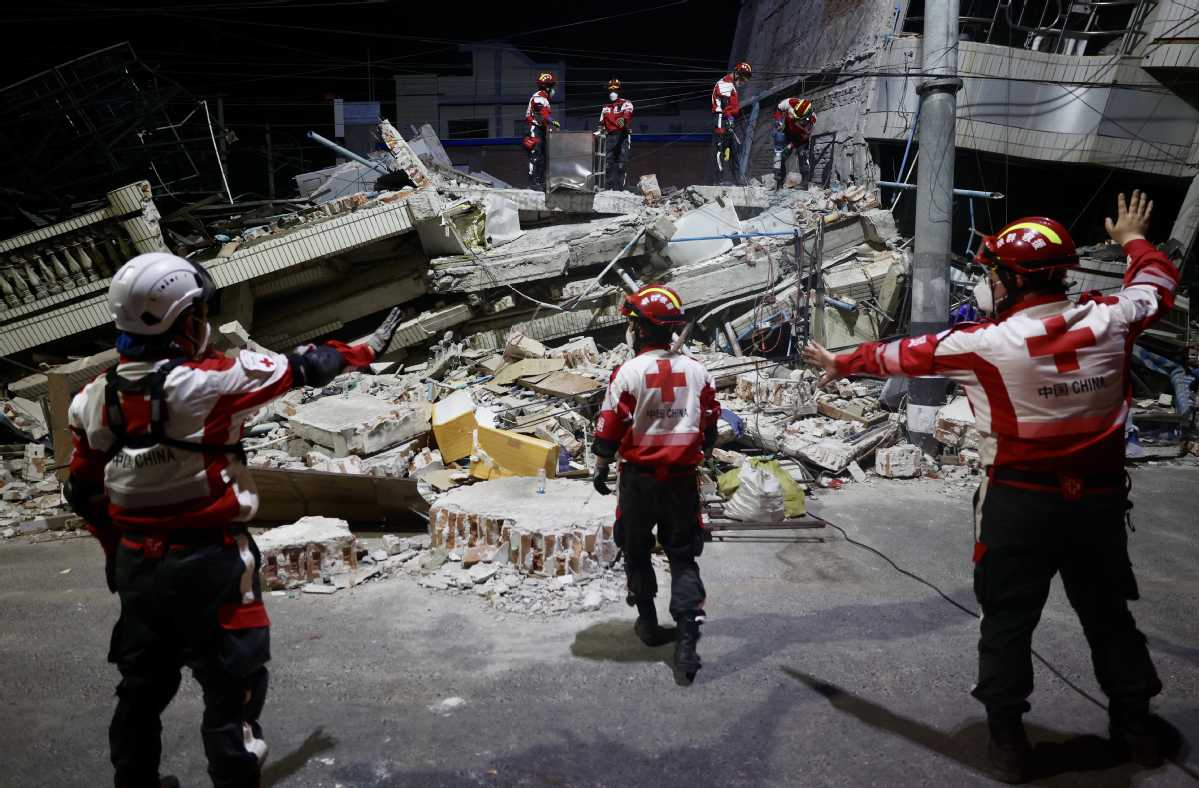
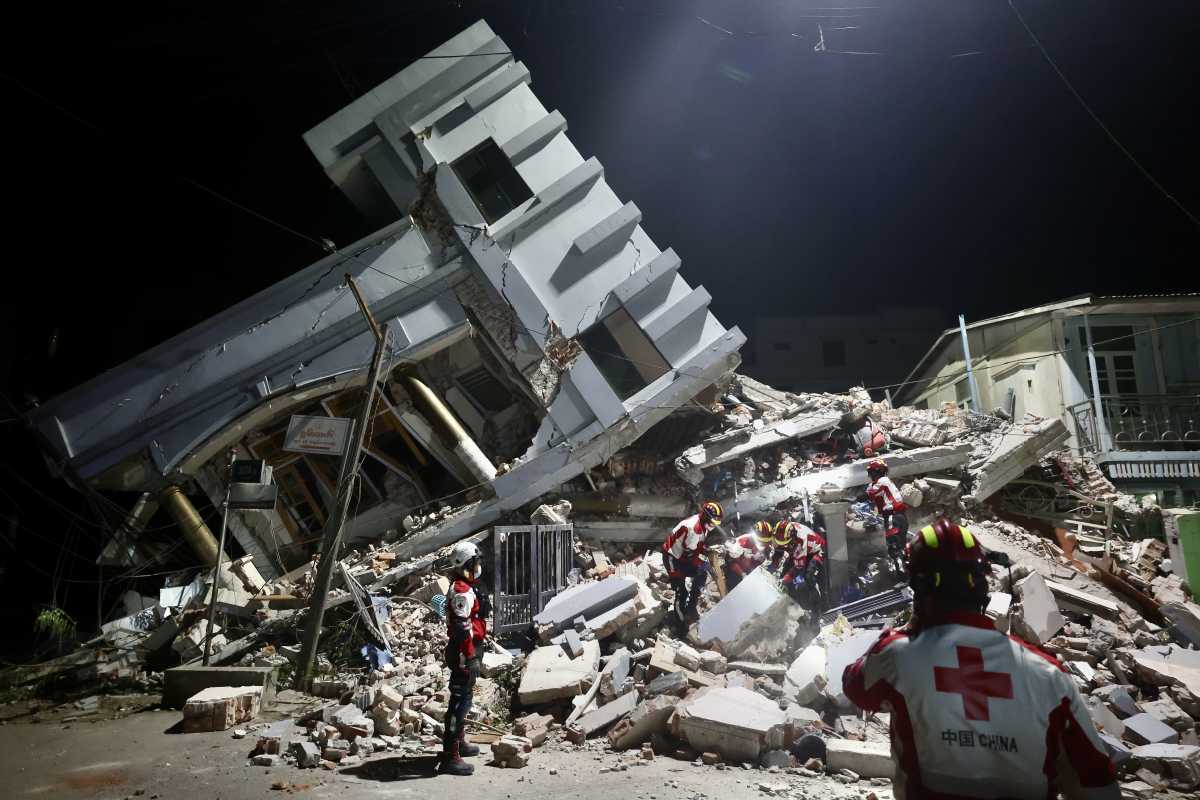
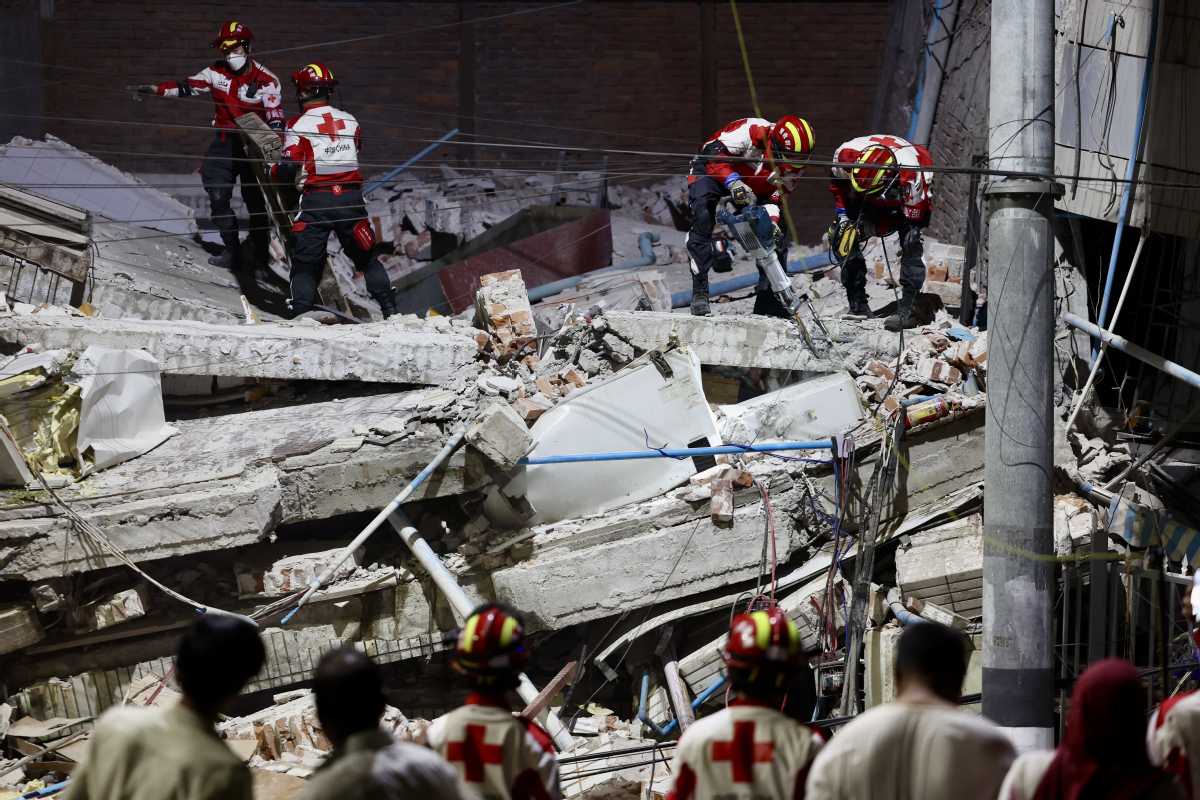
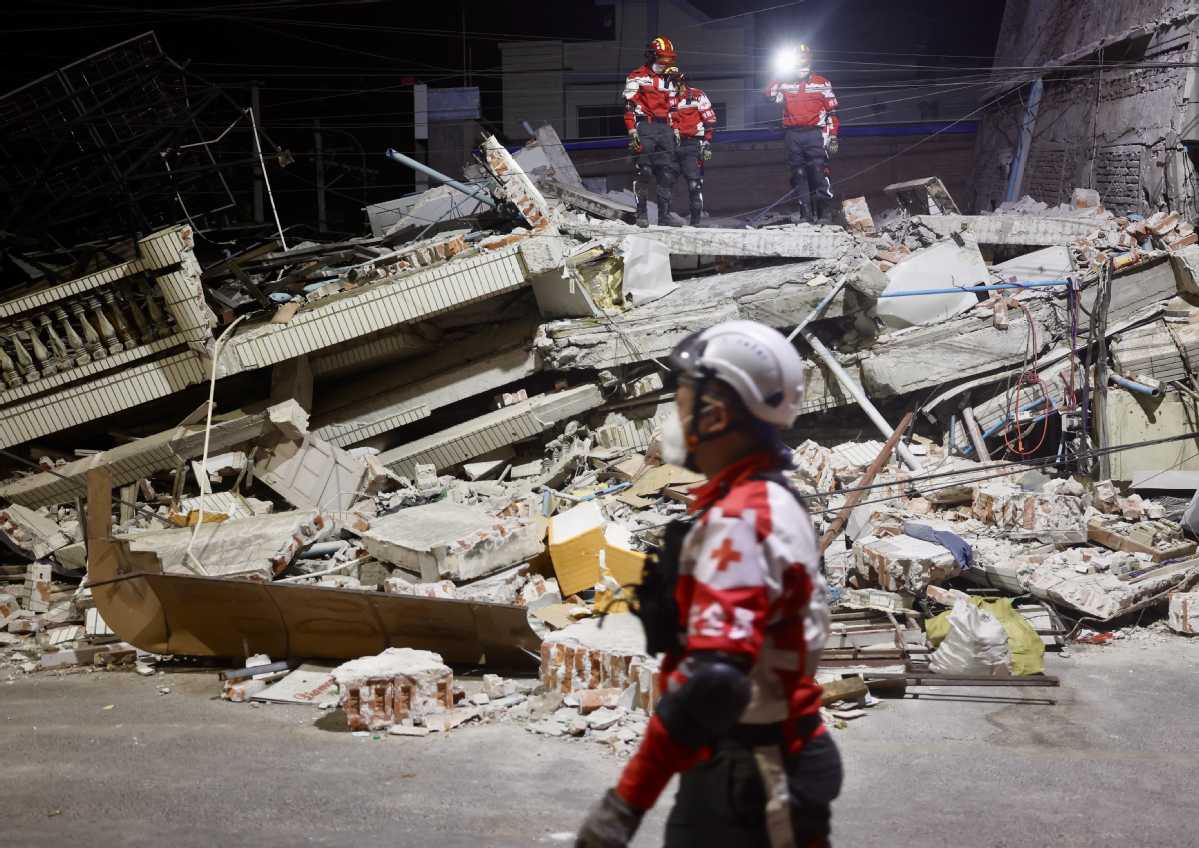
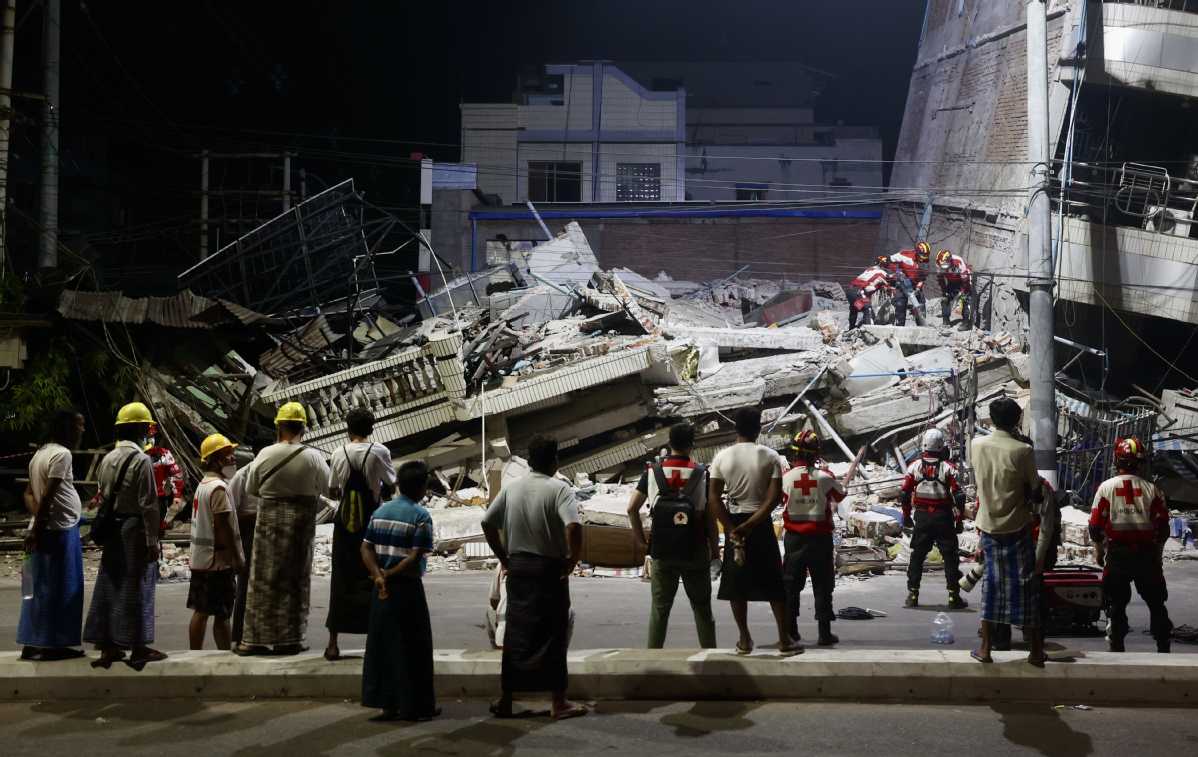
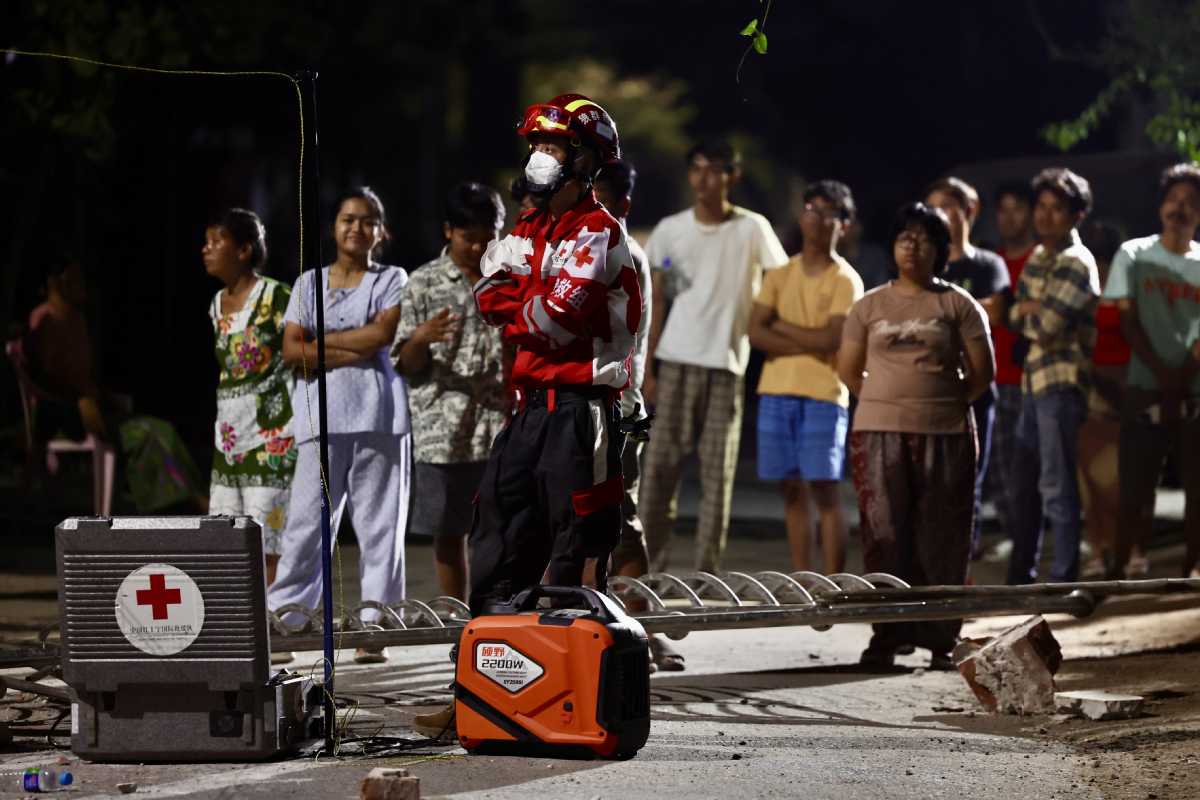
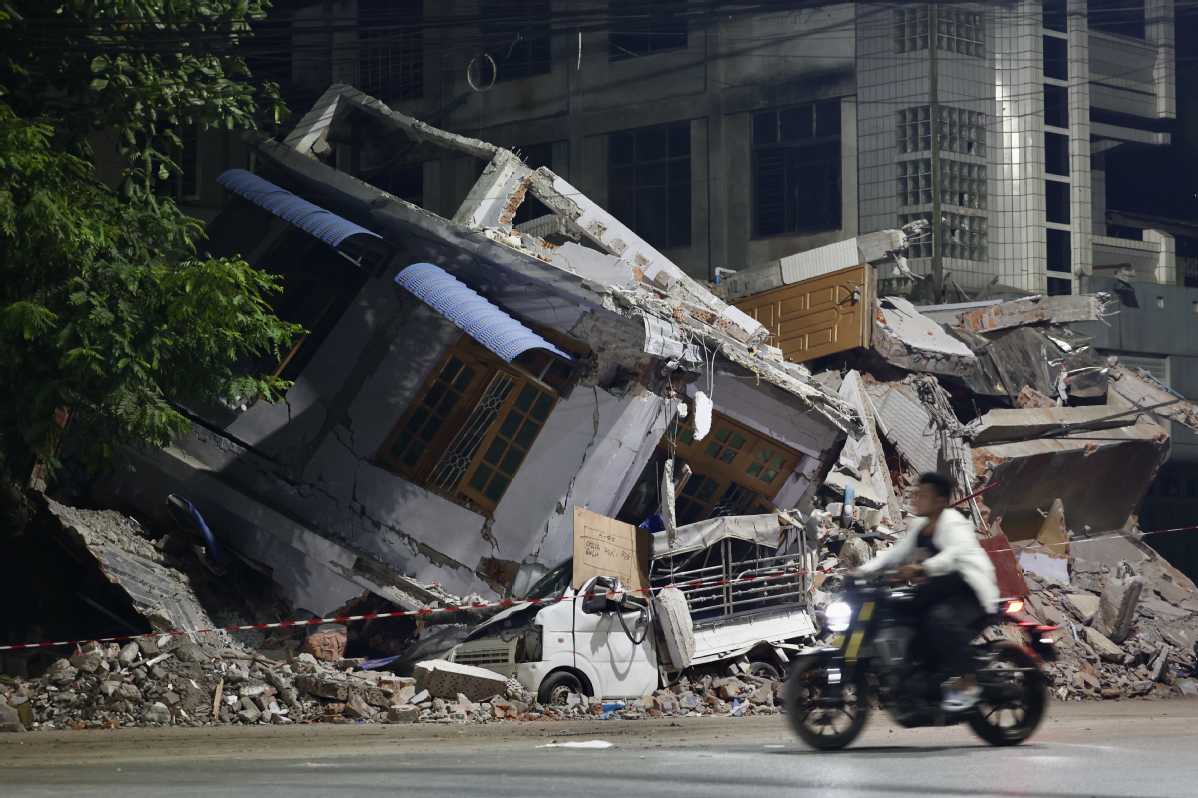
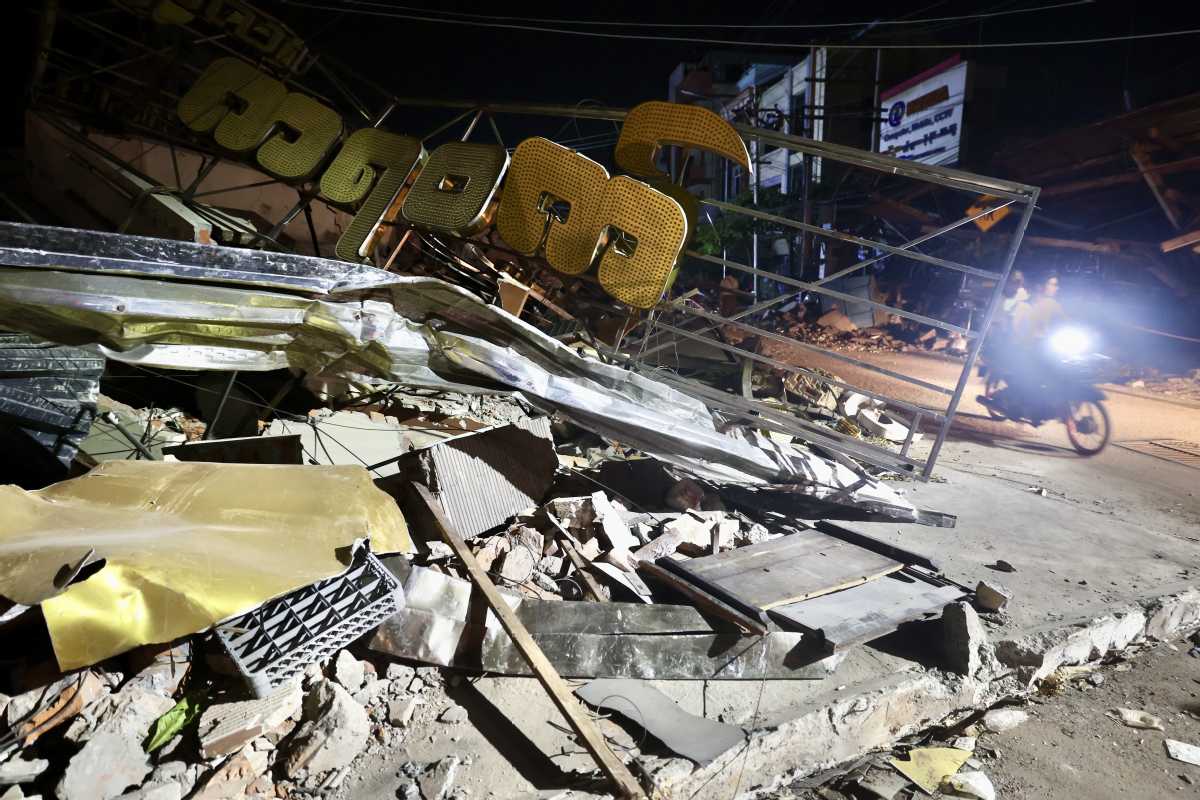
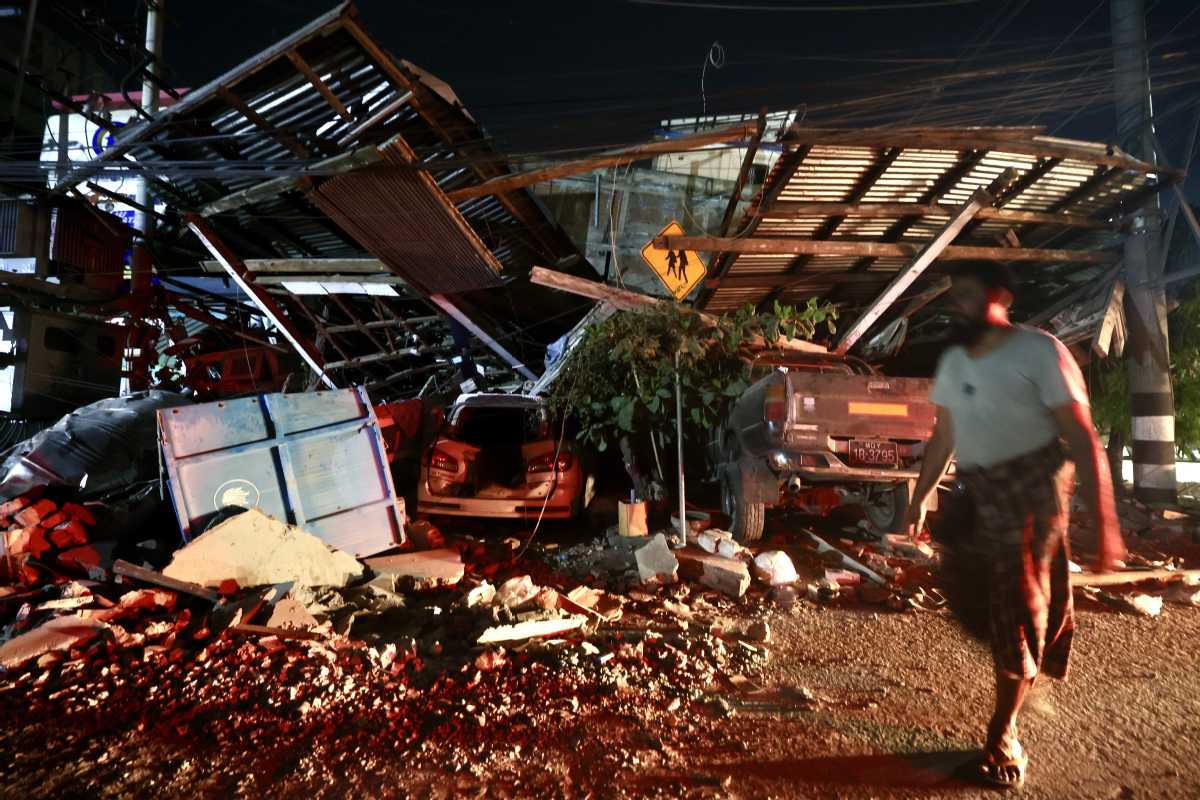
Upon arriving in Yangon, Myanmar, on Sunday evening, I rushed to Mandalay overnight with the Chinese Red Cross International Emergency Response Team that was carrying supplies.
The bus was loaded with supplies donated by Chinese social organizations. Among them were three large packages wrapped in woven bags placed in the aisles between seats.
I asked what they were and got a chilling answer that brought home the serious nature of the disaster: body bags.
After a night of rough travel, the team arrived in the city around 8 am on Monday.
It took about 14 hours on the road. I heard from the locals that it usually takes half that time to make the journey.
Many main roads were closed, so we had to take detours, and we were stopped and questioned several times by checkpoints set up by the government army.
As we approached Mandalay, the destruction of dwellings along the way increased.
In the city, most residential houses had some kind of damage. Many buildings were in danger of collapse, and lots of residents were camping on the roadside or on sports fields.
After arriving, the team members immediately started rescue work without taking a rest.
I was wearing a Chinese Red Cross rescue uniform, and went around taking photos with the guidance of a local overseas Chinese volunteer.
The feedback from local people was very positive. Some shop owners offered free drinking water, some greeted us in Chinese saying "Nihao", while others smiled and said "China" while giving a thumbs-up.
I met an overseas Chinese whose house — a four-story building — collapsed in the earthquake, with only remnants of the top floor.
Upon seeing me, he tentatively asked if the rescue team could help retrieve some important items, including identification cards, that were buried in the rubble. The team leader promised to later find time to help him.
On the first day in Mandalay, the most challenging aspect was the high temperature, with a maximum temperature of 42 C.
Even at noon, the hottest part of the day, the rescue work never stopped.
After returning to their makeshift base at a sports hall, the Chinese rescuers immediately took off their uniforms and lay on the ground.
This trip to Myanmar was the first international rescue mission of the team I had accompanied.
I was deeply moved by the humanitarian spirit and professional capabilities of the team members, who are all from Hangzhou, Zhejiang province.
Among the 15 members, there is one female member, Chen Ying. She has been engaged in rescue work for 10 years and is responsible for logistics, psychological counseling, and medical assistance on this trip.
Facing my interview camera, she said, "As a member of the Red Cross, our original intention has long surpassed life itself. I hope everyone stays safe."
Zhang Xiaomin contributed to this story.
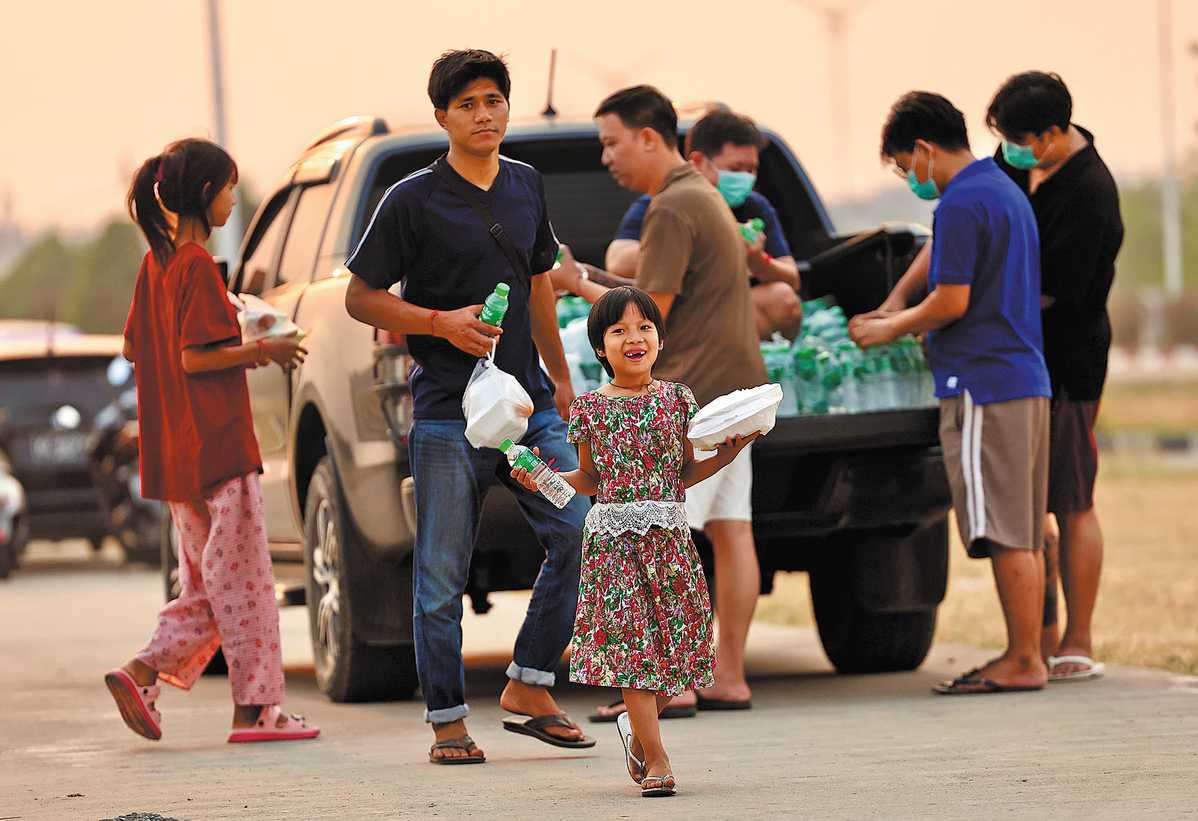
An elderly woman was successfully rescued by a Chinese rescue team from under hospital rubble in Myanmar's capital, Nay Pyi Daw, on Sunday morning, nearly 40 hours after the magnitude 7.9 earthquake struck on Friday.
"When she was carried onto a stretcher by rescuers, everyone on the scene was excited," said Mu Shuyuan, from China's Yunnan province rescue and medical team.
The 37-member team was the first international one to arrive at the earthquake-stricken area. Eighteen of the team members are from China Railway No 2 Engineering Group's National Tunnel Emergency Rescue Team based in Kunming, the capital of Yunnan. They are responsible for rescue efforts, while the others take care of medical needs and help with disease prevention.
Carrying emergency rescue supplies, including life detection equipment, an earthquake early-warning system and portable satellite equipment, the team arrived at Yangon International Airport on Saturday morning.
Upon landing, they immediately joined forces with the Myanmar fire and rescue department, and after traveling for more than nine hours reached severely affected areas in Nay Pyi Daw.
"Without taking a break, we brought demolition tools and communication equipment to the designated location, and quickly engaged in rescue work," said Mu, leader of the rescue squad.
At Ottara Thiri Private Hospital, a three-story building was severely damaged, with the ground floor completely collapsed.
Using a sign of life detector, Mu's squad located a survivor trapped under the collapsed floor.
His deputy Xiao Min crawled in front of a crevice in the rubble, shone a flashlight in the space and called out loudly in Mandarin with a Guizhou accent, "Don't be afraid. We are here to rescue you!"
Realizing there was a language barrier, Xiao immediately called for a translator. The translator was able to communicate the message, and a hoarse response was heard emanating from deep within the debris.
A 73-year-old woman, who had previously undergone brain surgery and returned to the hospital for a checkup, was trapped in a narrow space between the second and first floors, alongside bodies of the deceased.
Due to the complex environment, they devised a rescue plan along with local emergency workers.
"During the rescue process, we not only had to consider that drilling vibrations might cause concrete blocks to fall, causing secondary harm to the trapped individuals, but we also had to be vigilant about aftershocks and the risk of collapse," Xiao said.
After drilling two access holes, one running horizontally and the other vertically, they still could not reach the woman. They then drilled a third hole, which enabled them to remove the bodies of two deceased people on top of the woman.
At 4:56 am on Sunday, after being trapped for nearly 40 hours, she was successfully rescued.
"Make sure to lift steadily and slowly," Xiao repeatedly instructed those carrying the stretcher. When she was safely placed in an ambulance, he let out a sigh of relief.

Heartfelt gratitude
After saving the woman, Mu led the squad to the main building of the hospital, where a trembling elderly man grabbed his wrist and spoke in a croaky voice to him.
Translators and local firefighters informed Mu that the man was a relative of a victim whose body had been retrieved from the debris.
Despite the outcome not being as desired, he expressed deep gratitude for the hard work of the rescue team.
"Although we couldn't understand each other's languages, his emotions and sincerity deeply touched us," Mu said.
On Sunday morning, Myanmar's leader Min Aung Hlaing visited the hospital and expressed heartfelt gratitude to the entire Yunnan rescue and medical team for their prompt arrival in Myanmar for rescue operations.
Medical team member He Jibo communicated and coordinated with accompanying Myanmar health officials. He said that they were very concerned about the occurrence and spread of infectious diseases due to poor hygiene.
The Chinese team will work with Myanmar's health department and disease control center to further clarify post-disaster health and epidemic prevention needs, He said.
"The rescue operation in the quake-hit area faces various difficulties. Myanmar, both officially and privately, is deeply moved by China's immediate mobilization for disaster relief," said Chin Myint, managing director of Yangon-based Myanmar Weimin Energy Technology Co.
"As far as I know, the number of Chinese rescuers who arrived in Mandalay has exceeded 300," he said on Monday.
Chin said he was on a business trip to Mandalay on Friday when he felt the strong earthquake while checking into his hotel.
He said he immediately went to the hardest-hit area of the city to assist front-line rescue workers and also participated in fundraising for the victims and survivors. "We need to do our best. The buildings have collapsed, but we cannot let hope collapse as well," he said.
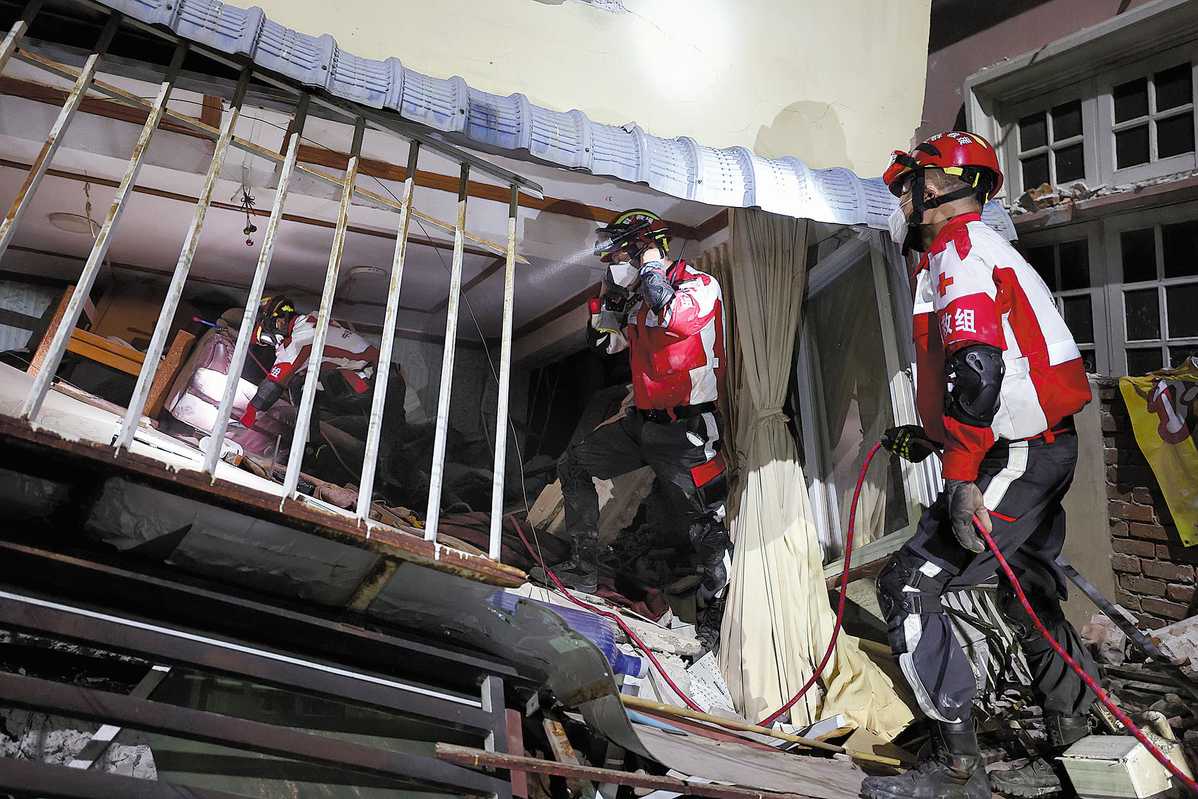
Responsible neighbor
The Yunnan rescue and medical team was joined in Myanmar by a Hong Kong search and rescue team, the China Search and Rescue Team, the China International Search and Rescue Team, as well as various civilian rescue forces from different parts of the mainland.
The Chinese Red Cross International Emergency Response Team traveled to Mandalay, where its 15 team members were involved in search and rescue efforts, care and transfer of survivors, medical assistance, and provided psychological counseling.
On Sunday, while preparing for departure at Kunming airport, they encountered a middle-aged Myanmar overseas Chinese named Sein Yee, who cried with excitement upon seeing the team.
Sein had planned to fly back to Mandalay from Mangshi of Dehong Dai and Jingpo autonomous prefecture, Yunnan, on Friday. Due to the earthquake, the flight was canceled so she transferred to Kunming.
"On one hand, I was moved because we were in distress, and China promptly came to our rescue," she said. "On the other hand, seeing the disaster scenes sent by friends after the earthquake made me very sad."
"My heart has been aching, hoping more people are rescued as soon as possible," she said.
Ma Yong, a researcher at the Yunnan Academy of Social Sciences, said that China and Myanmar form a community with a shared future. The two countries share "weal and woe", bound by a profound pauk-phaw ("fraternal" in the Myanmar language) friendship between their peoples.
"True solidarity shines brightest in times of adversity," Ma said. "Upon learning of the devastating earthquake in Myanmar, the Chinese government immediately extended assistance, with Chinese rescue teams being the first to arrive on the scene.
"They swiftly engaged in relief operations and announced humanitarian aid. The rapid and efficient involvement of Chinese rescue forces has helped people in Myanmar fight the disaster. This has further strengthened the 'heart-to-heart connectivity' between the peoples of China and Myanmar."
Ran Aobo, a researcher at Tsinghua University's Institute for Urban Governance and Sustainable Development, said China, as a responsible big country, had sent emergency response teams multiple times to other countries for disaster relief work.
China is a participant in Integrated Research on Disaster Risk, an international scientific program co-sponsored by the International Science Council and the United Nations Office for Disaster Risk Reduction, he added.
"China has a strong capability and willingness to enhance international cooperation in disaster relief," he said, adding that the country leverages its expertise in technical training and data sharing.
As Myanmar is an important neighbor, China's actions are also proof of the two countries' long-lasting friendship, he added.
Chen Meiling contributed to this story.
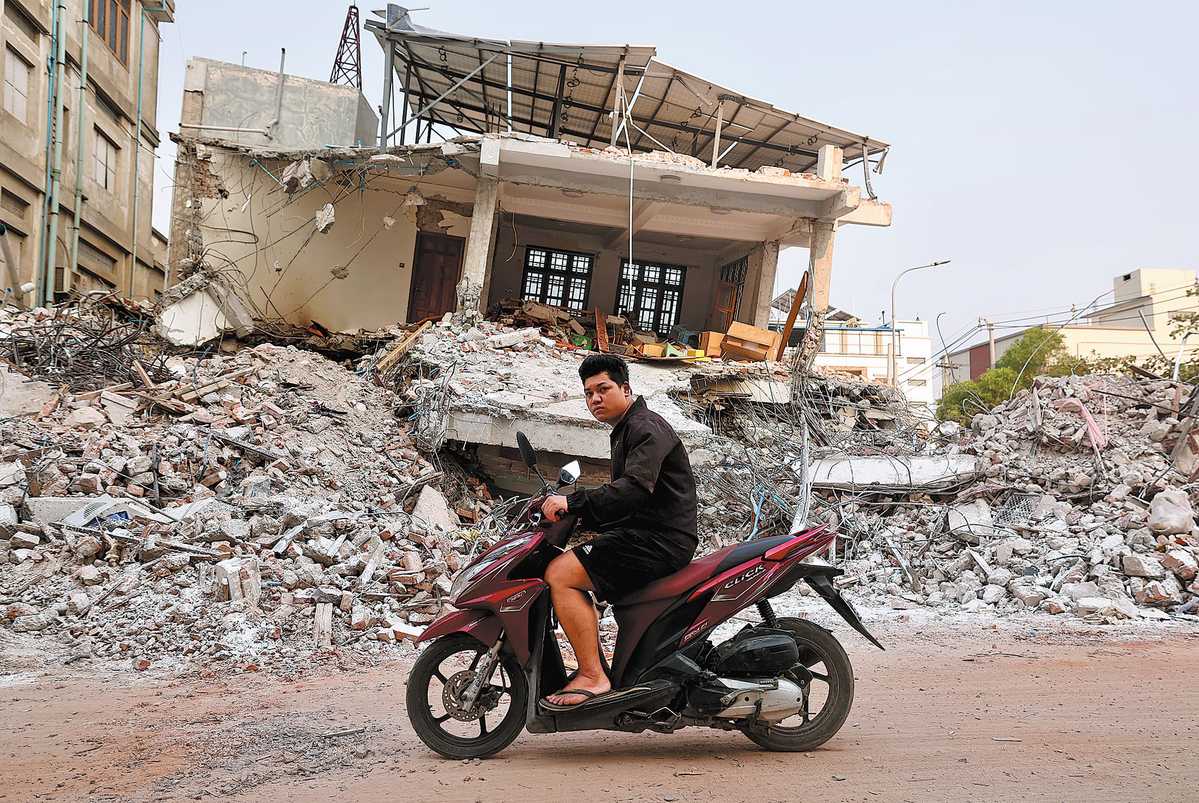
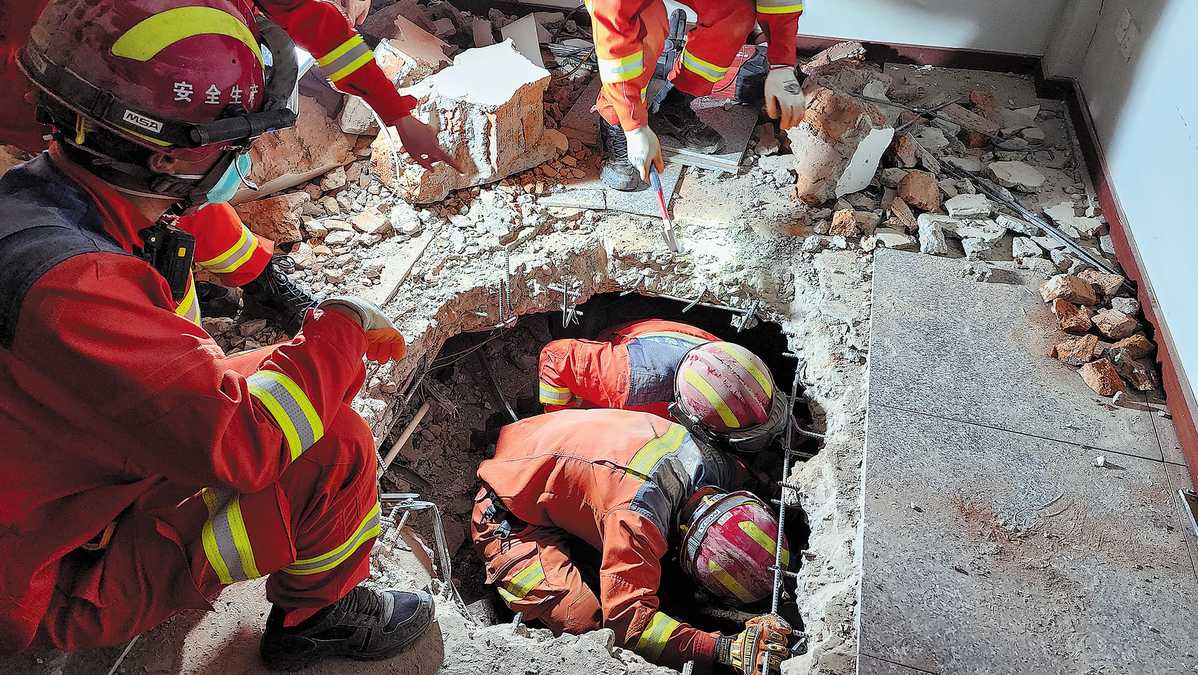
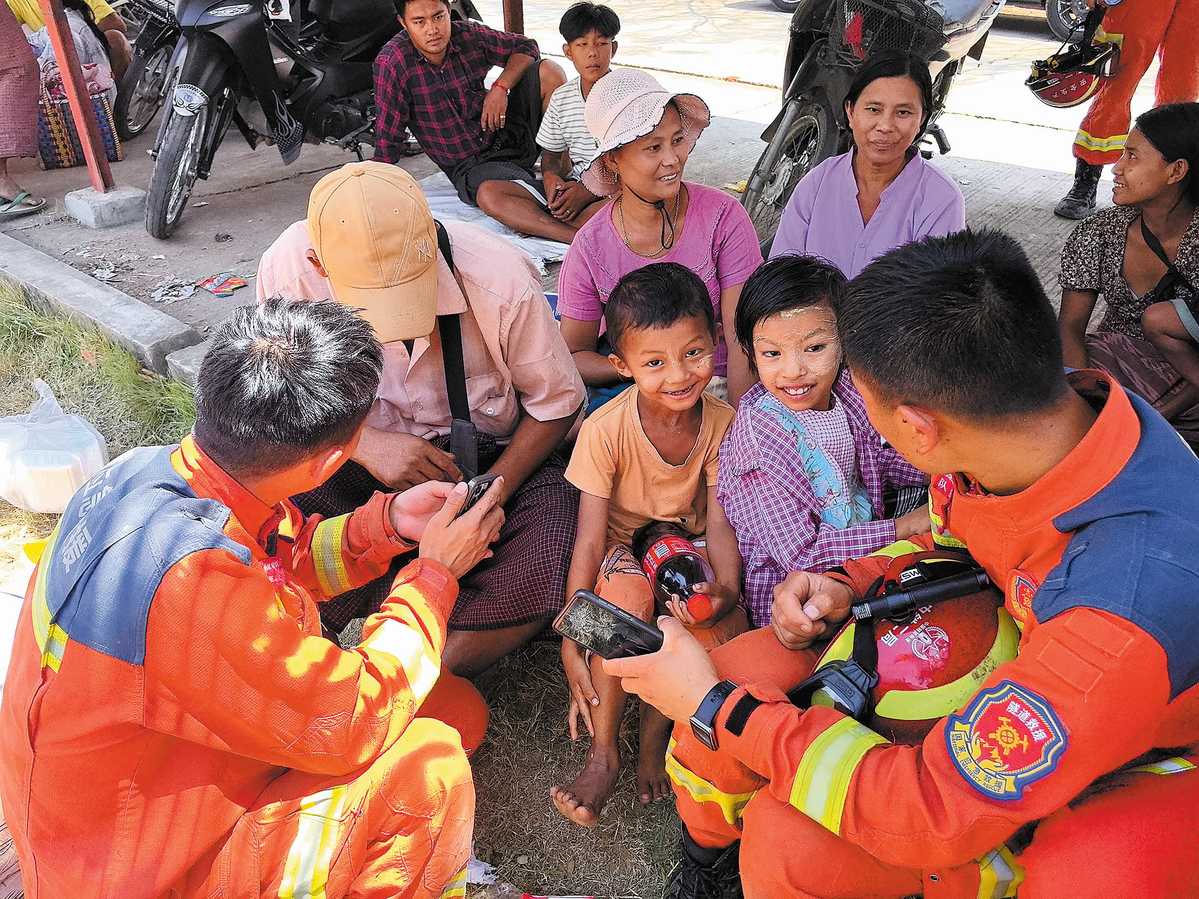


MANDALAY, Myanmar -- Chinese rescue teams are continuing to work in the hard-hit Mandalay in central Myanmar following the 7.9-magnitude temblor last week, and have so far saved eight survivors as of 08:00 local time on Tuesday in the country.
The China Search and Rescue Team saved four survivors, the Yunnan Rescue Medical Team rescued one survivor, and other civil emergency forces rescued three and assisted the China Search and Rescue Team.
To coordinate the Chinese rescue teams in Mandalay, a rescue work mechanism was established to enhance information sharing and joint logistics to ensure the quality and effectiveness of their rescue work.
Currently, the weather in Mandalay is hot, with the highest daytime temperature topping 40 degrees Celsius, and there are many mosquitoes at the work sites.
Meanwhile, experts from the Chinese Search and Rescue Team have completed the safety assessment of the damage to the four office buildings of the Chinese Consulate General in Mandalay, and offered proposals on emergency disposal.

YANGON -- Myanmar observed a one-minute silence on Tuesday to honor the victims of the devastating earthquake that has claimed over 2,000 lives.
At precisely 12:51:02 local time, the moment the 7.9-magnitude quake struck near Mandalay, sirens rang out across the nation in remembrance of those lost.
Myanmar announced on Monday a week-long mourning period following a 7.9-magnitude earthquake that struck Myanmar on March 28.
As of 8 am local time on Tuesday in Myanmar, Chinese official and civil rescue teams have rescued a total of eight people following the 7.9-magnitude earthquake that struck on Friday, according to the Ministry of Emergency Management.
On Monday, the rescue team from Hong Kong SAR and the China International Search and Rescue Team met with China Search and Rescue Team.
To coordinate the efforts of the Chinese rescue teams in Myanmar, the ministry has established a unified rescue mechanism. This includes joint meetings, information sharing, coordinated rescue operations and shared logistical support, aiming at enhancing collaboration between the various teams and ensuring the effectiveness of the rescue operations, the ministry said.
Currently, the disaster area is experiencing hot weather, with daytime temperatures exceeding 40C. The rescue sites are also infested with mosquitoes. In response, the Chinese rescue teams are adhering to a rotational shift system for team members, and sanitation measures for personnel and equipment are strictly followed, according to the ministry.
Disinfection is conducted regularly within and around the campsite to maintain hygiene and ensure epidemic prevention safety, the ministry added.
Additionally, earthquake engineering experts have completed a safety assessment of the damage to four office buildings at the Chinese consulate general in Mandalay and have provided targeted emergency response recommendations.

Rescue and medical teams from across the Asia-Pacific region are continuing relief and search operations in Myanmar, helping the nation recover from Friday's devastating magnitude 7.9 earthquake.
The disaster killed 2,056 people in Myanmar as of noon on Monday, injured about 3,900, with 270 missing, and sent violent tremors to nearby Thailand.
India, Indonesia, Malaysia, Singapore, Thailand and Vietnam sent emergency response teams to Myanmar soon after the quake, while the Philippine disaster response team will arrive on Tuesday.
Japan has dispatched an assessment team and will provide emergency relief supplies to those affected by the earthquake through the Japan International Cooperation Agency, the country's Ministry of Foreign Affairs said.
Foreign ministers of the Association of Southeast Asian Nations and Timor-Leste held an emergency meeting on Sunday to discuss humanitarian aid to Myanmar.
They agreed to strengthen relief and recovery efforts through the ASEAN Standby Arrangements and member states' contributions.
Malaysian Prime Minister Anwar Ibrahim, this year's rotating chair of ASEAN, conveyed Malaysia's condolences and pledged to distribute 10 million ringgit ($2.25 million) in humanitarian aid to Myanmar citizens affected by the tragedy.
In a message posted to his social media account Sunday, Anwar said he had directed Malaysian Foreign Minister Mohamad Hasan to lead a humanitarian mission to Myanmar this week. He had also called Thai Prime Minister Paetongtarn Shinawatra to express his deepest condolences and sympathy, Anwar said.
In the Thai capital of Bangkok, the death toll has hit 19, rescuers said on Monday.
The earthquake — measured as a magnitude 7.9 by the China Earthquake Network Center and a magnitude 7.7 by US authorities — is the strongest the region has experienced in nearly 200 years. The last temblor of a similar scale was recorded in the 1830s.
India said it had dispatched 15 metric tons of relief items by aircraft to Yangon, including ready-to-eat meals, blankets and generator sets. Indian Foreign Ministry spokesman Randhir Jaiswal said New Delhi had also sent four naval ships with relief supplies.
Australia will provide an initial A$2 million ($1.25 million) to Myanmar through the International Committee of the Red Cross, or ICRC. The funding will help the ICRC carry out immediate lifesaving support, such as addressing emergency medical needs.
Canberra also welcomed the release of $5 million from the UN Central Emergency Response Fund to support urgent needs such as shelter, food and water.
Cambodian Foreign Minister Prak Sokhonn said on Sunday that the kingdom would provide Myanmar with $100,000 in initial emergency assistance.
The United Arab Emirates also has expressed its sympathies and solidarity with the governments and peoples of Myanmar and Thailand, and the families of the victims.
In a statement on Saturday, Pakistani President Asif Ali Zardari offered condolences for the loss of human lives and affirmed support for those affected.
Prime Minister Shehbaz Sharif also offered Pakistan's assistance to Myanmar and Thailand, saying "our thoughts and prayers are with the people of both countries as they pass through this difficult time".
Cui Haipei in Dubai, Jiang Xueqing in Tokyo, Xin Xin in Sydney and Xu Weiwei in Hong Kong contributed to this story.
prime@chinadailyapac.com


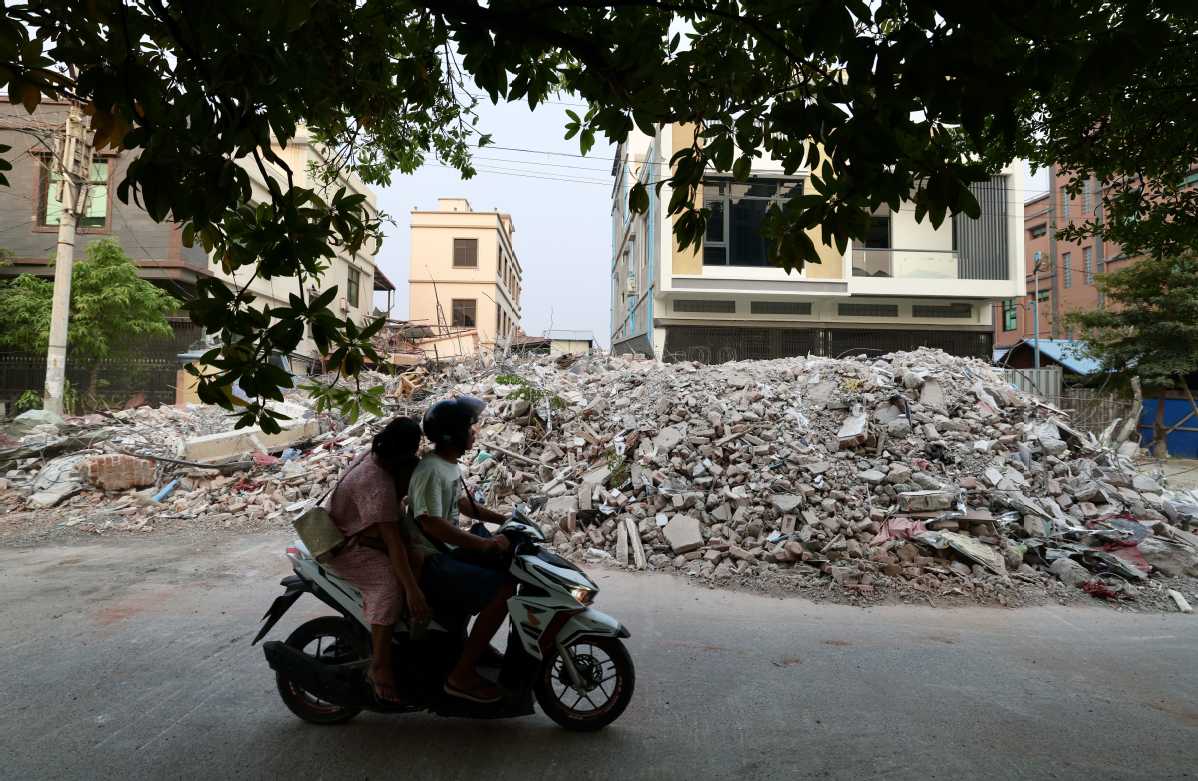
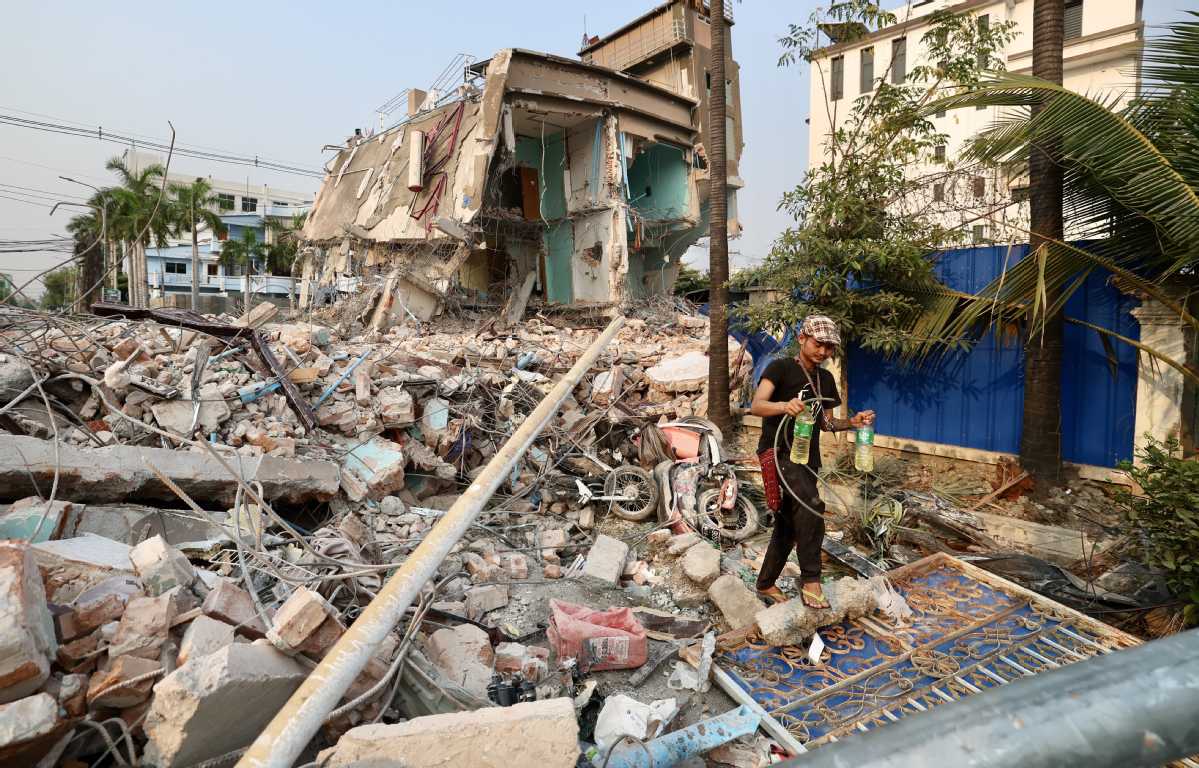
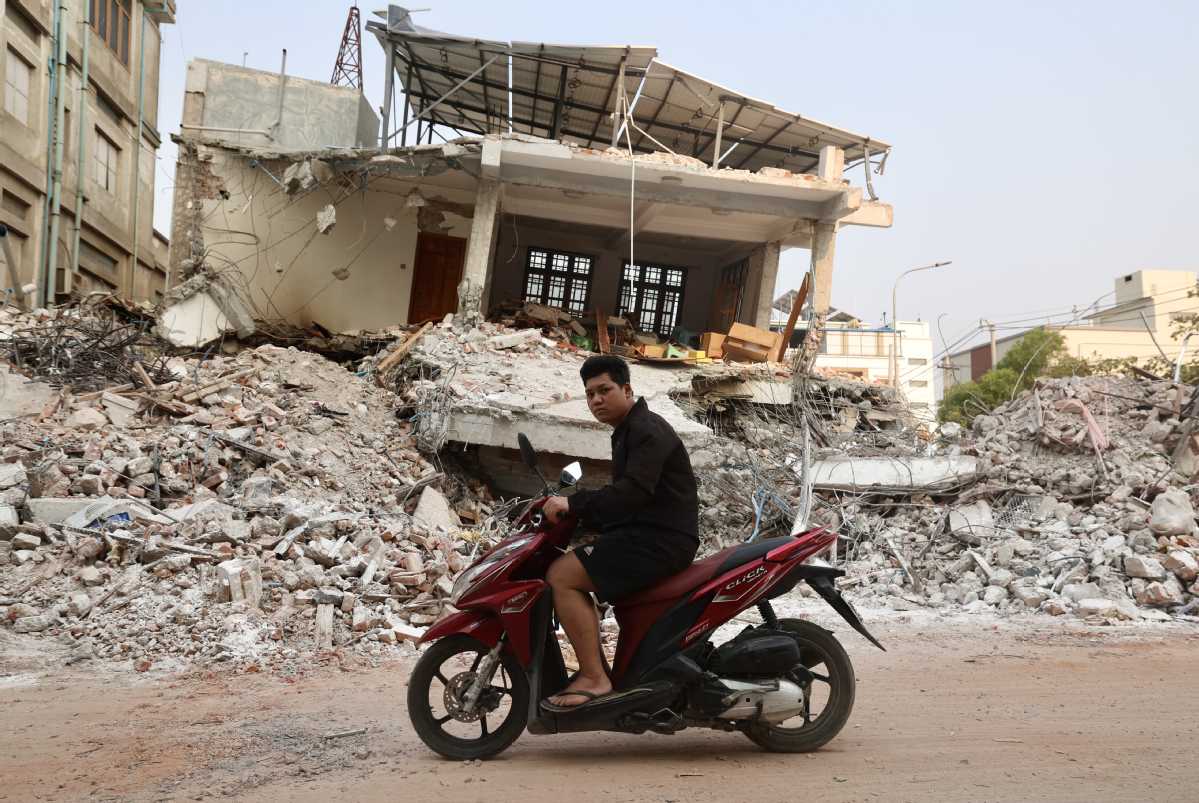
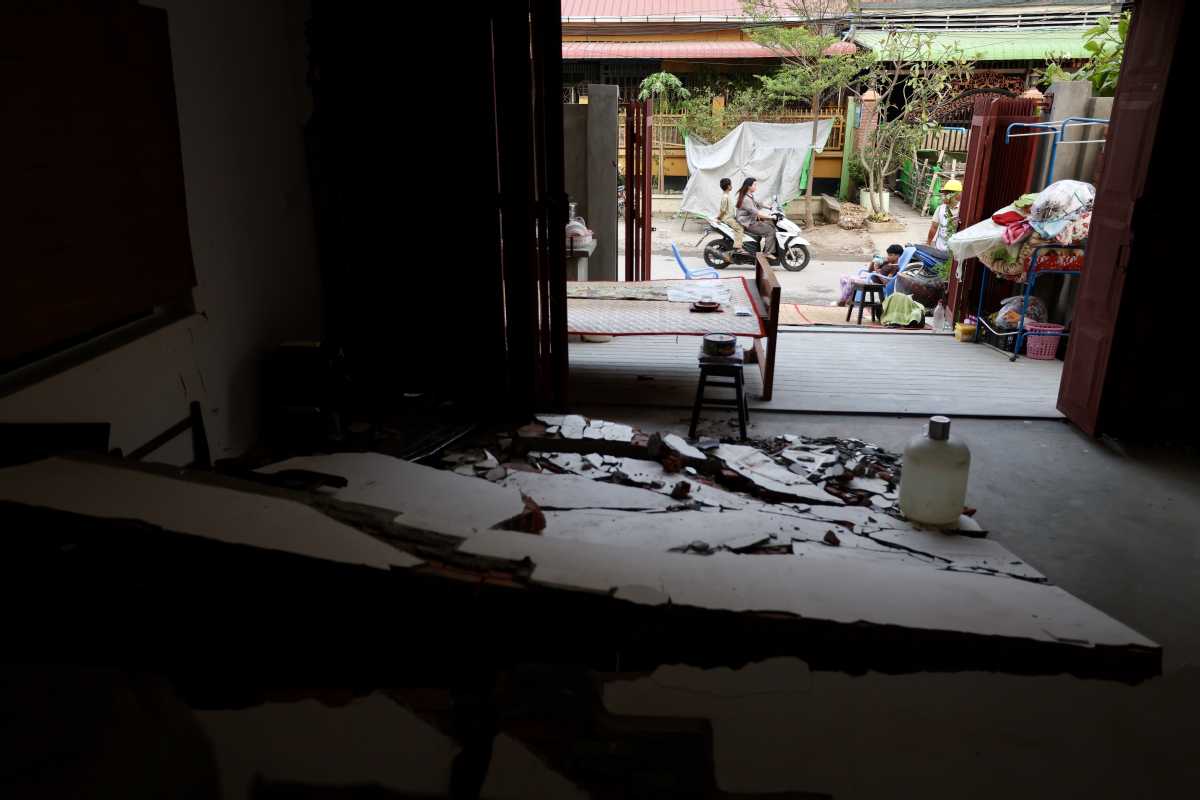
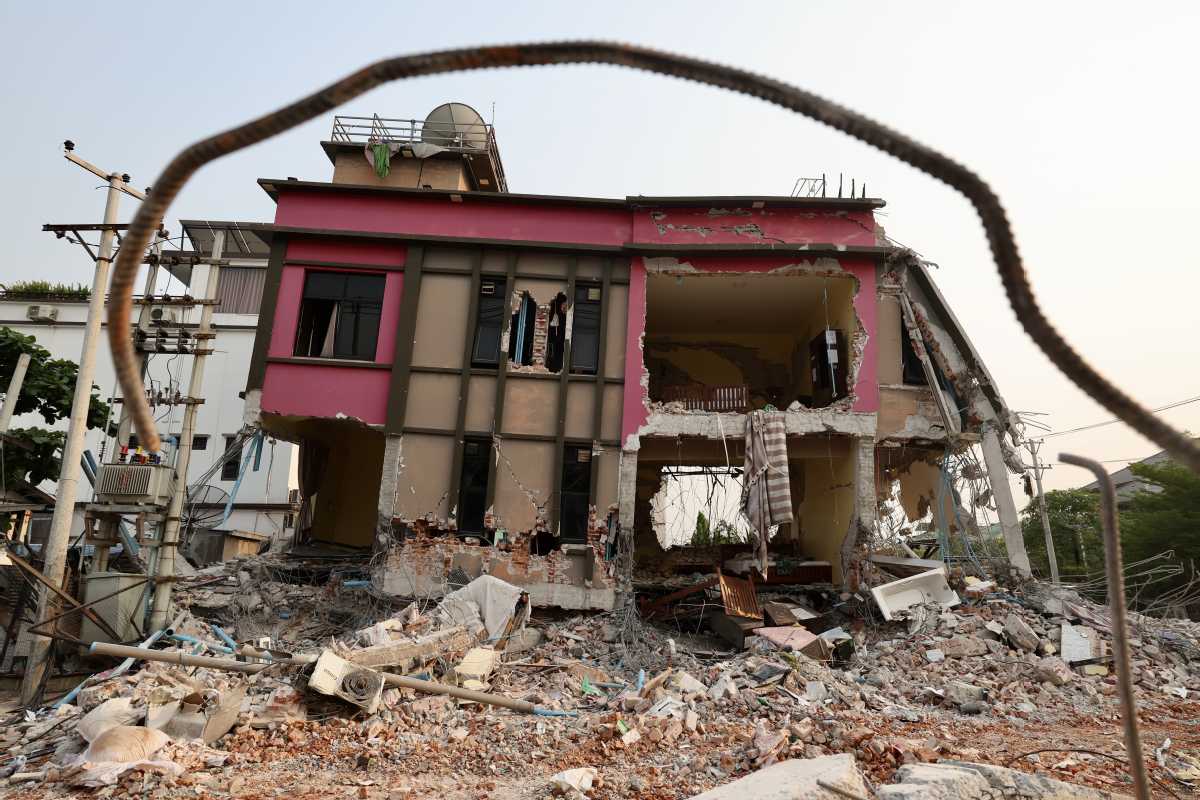


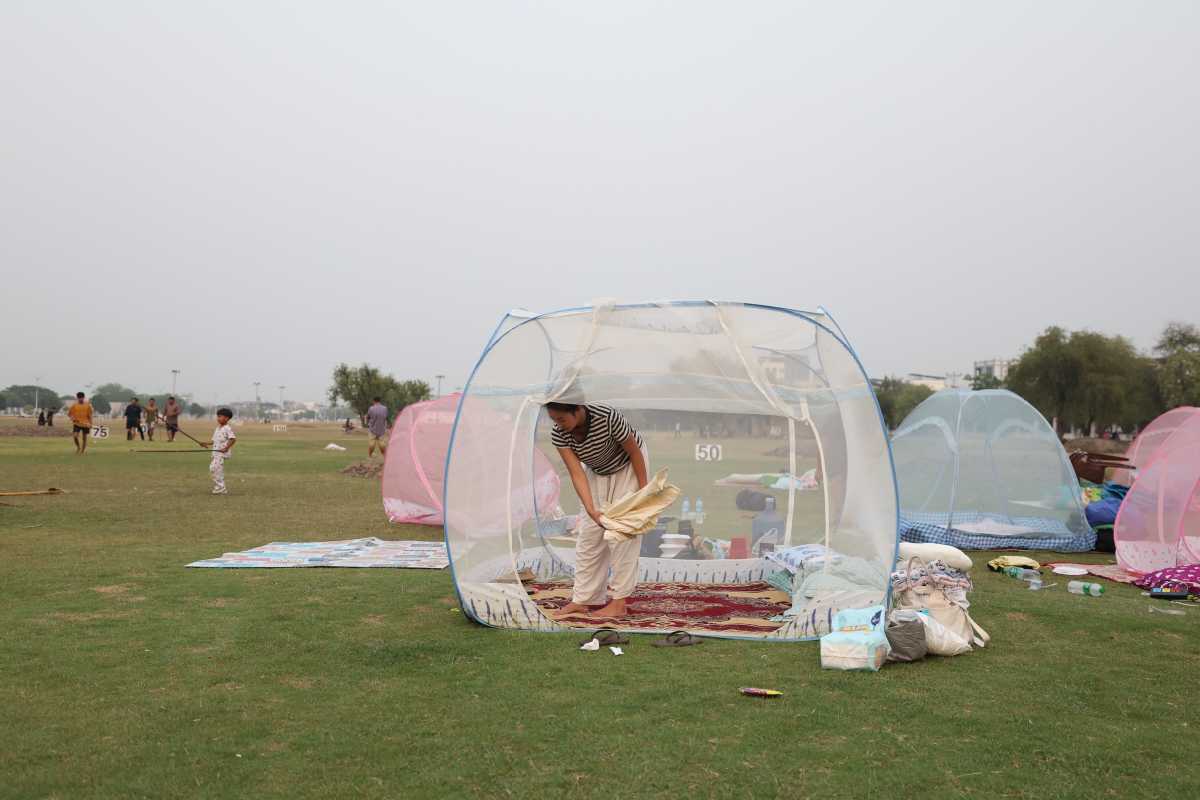
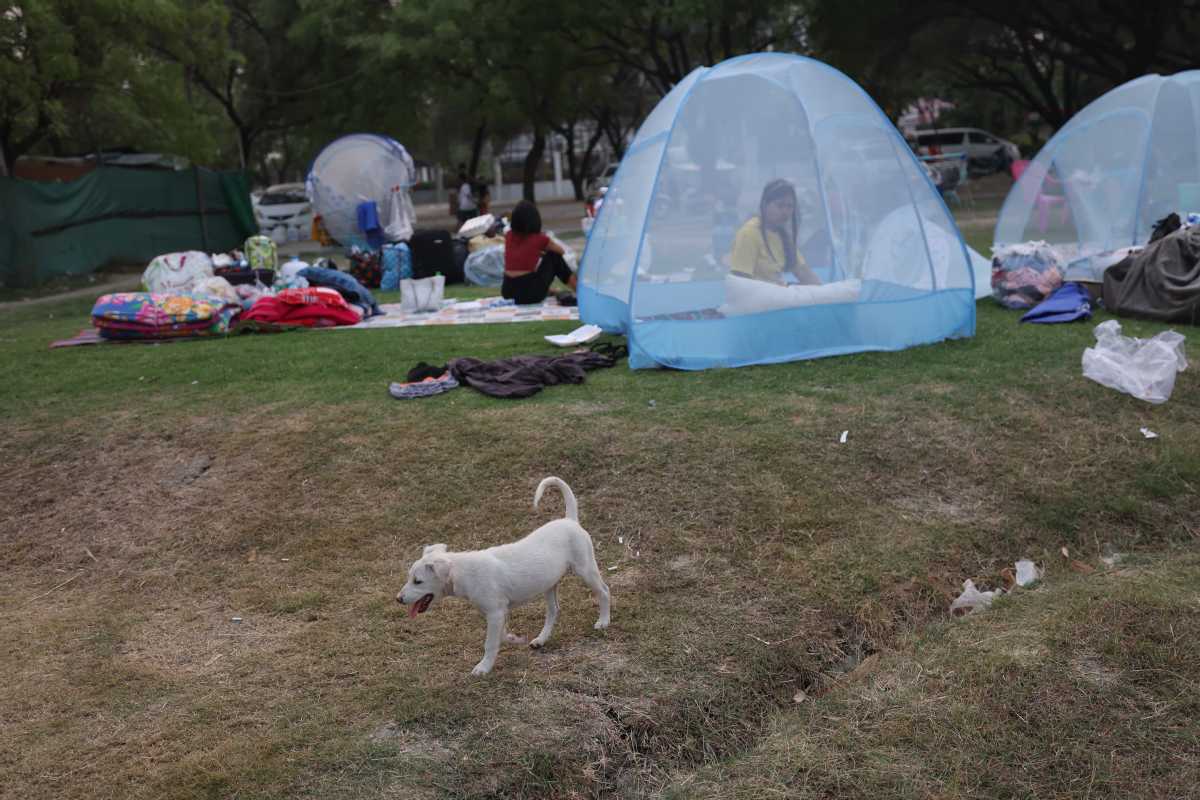


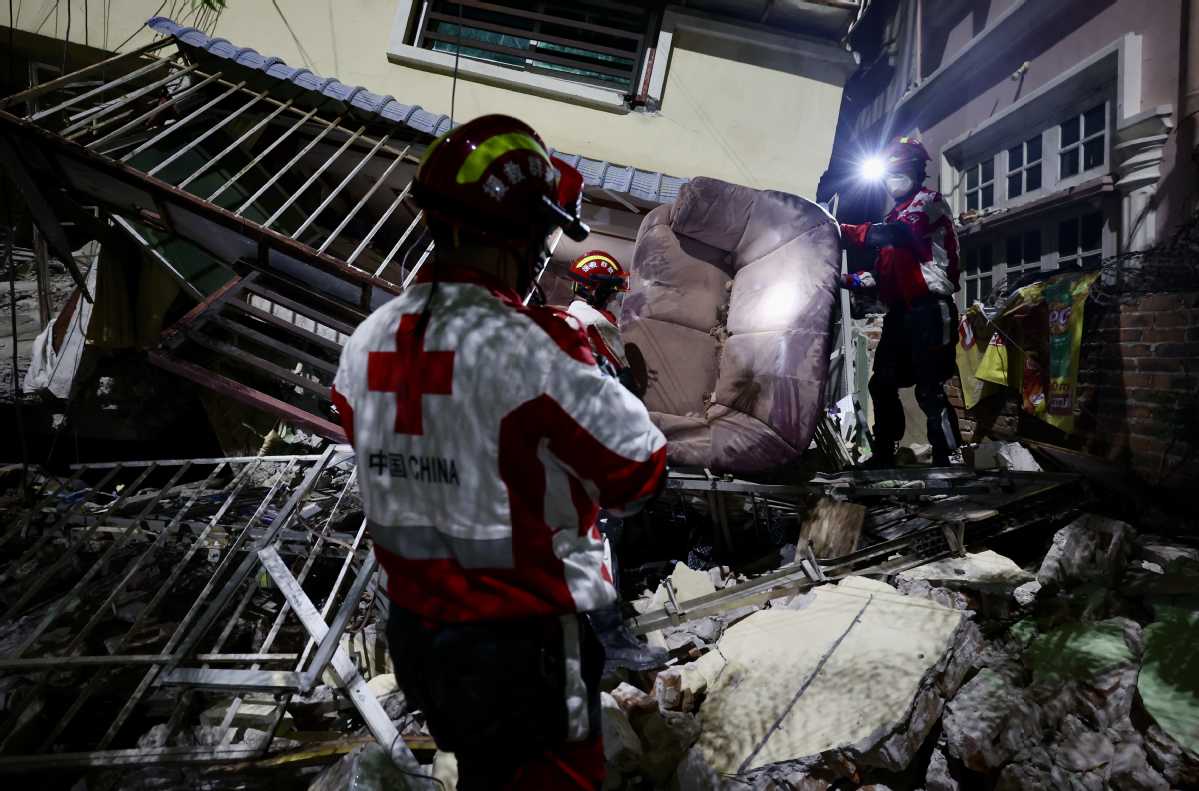

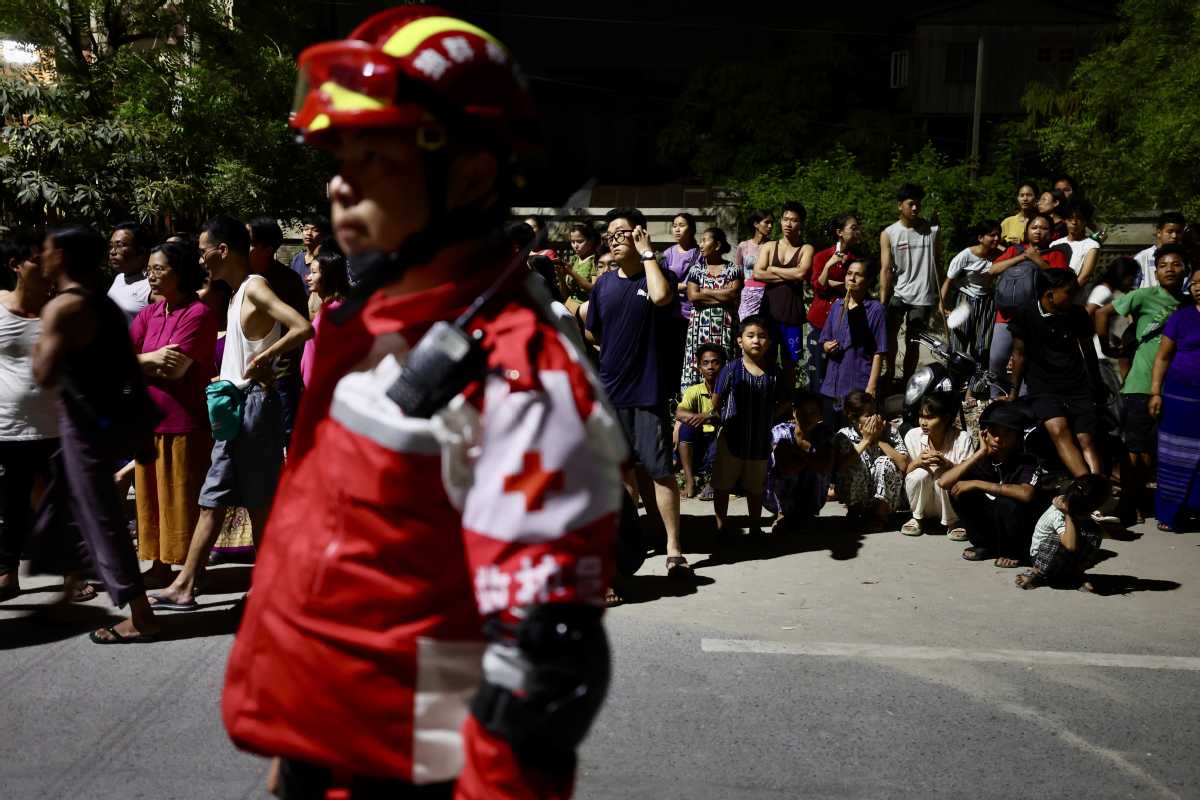
When a powerful 7.9 magnitude earthquake struck Myanmar on Friday, Cao Lei, a Myanmar language teacher in China, quickly volunteered to translate distress messages, helping relay critical information to rescue teams.
"After the earthquake, many Chinese rescue workers struggled to quickly and accurately understand Myanmar language distress messages from those affected in Myanmar," said Cao, who teaches at Tianjin Foreign Studies University. "Prompt translation improves rescue efficiency and helps victims escape more swiftly."
In response, Myanmar language students and faculty from Beijing Language and Culture University formed an emergency language service group. They translated online distress messages into Chinese, marked key details on a map and shared it with rescue teams.
Cao joined the effort, volunteering with the Zhuoming Disaster Information Service Center to provide translation, information verification and resource coordination.
Over the weekend, he worked more than 32 hours. On Monday, after finishing his morning class, he resumed searching for and translating information online. He monitored Myanmar language reports from BBC and Voice of America, as well as Burmese media outlets like DVB and Eleven.com. He also scoured social media platforms including Facebook, Instagram and X, translating key updates into Chinese for the center.
The center processed the information and immediately relayed it to front-line Chinese rescue teams.
"The first day, I translated up to 100 messages for rescue and earthquake response points," Cao said. "Then from 8 am Sunday, I worked until 2 am Monday because we needed to grasp the 'golden 72 hours' for earthquake rescue."
Despite being thousands of kilometers away, Cao said he deeply empathizes with those seeking help, feeling their anxiety as he reads each message while translating.
"Initially, requests for assistance mainly came from commercial buildings and private residences in Mandalay, Myanmar. Later, there were also numerous requests from schools and temples. I have been racing against time to quickly and accurately convey these life-or-death messages," he said.
Before joining the university in 2013, Cao worked for four years on a hydropower project in Myanmar with a Chinese enterprise. He said the experience gave him a deep understanding of the country and a strong connection with its people.
"The earthquake has put countless lives at risk," he said. "As an educator who has worked in Myanmar and has taught the Myanmar language for many years, I feel a profound responsibility to help."
By Monday morning, China had sent several rescue teams to Myanmar, and Chinese rescuers had saved six people from quake-damaged areas.
yangcheng@chinadaily.com.cn

Multiple rescue teams from China have rescued six survivors, including a pregnant woman, in earthquake-hit Myanmar as of 8 am local time on Monday, as the first group of emergency humanitarian aid from China arrived in the Southeast Asian country.
The magnitude 7.9 earthquake, which struck Myanmar on Friday, has resulted in 2,056 deaths and more than 3,900 injuries, and over 270 people were still missing as of Monday night, according to the country's state television channel MRTV.
Meanwhile, three Chinese citizens were killed and 14 injured in the massive earthquake as of 5 pm local time, Chinese embassy in Myanmar said.
According to the Ministry of Emergency Management, the China Search and Rescue Team arrived in the hard-hit city of Mandalay on Sunday afternoon local time and immediately sent an advance unit to conduct on-site assessments and rescue operations.
At 12:40 am on Monday, the team rescued a woman near a hotel. In addition, the CSRT and China's Zhejiang Rescue Team of Ramunion, a civilian rescue organization, worked together to rescue three trapped women near an apartment building in Mandalay on Monday morning.
The rescued individuals were transported to medical facilities for treatment, and rescue efforts were still ongoing, the Ministry of Emergency Management said in a news release.
In addition, an elderly man who had been trapped for nearly 40 hours under the rubble of a hospital in Nay Pyi Daw on Sunday was rescued by a team from Southwest China's Yunnan province, Xinhua News Agency reported. Also on Sunday, members of the Blue Sky Rescue Team from Hunan province rescued a survivor at Mandalay Buddhist Hall.
According to the Ministry of Emergency Management, a total of 91 members from five social emergency response teams organized by the ministry have arrived in Myanmar and are participating in or assisting with the rescue operations.
Following assessments, the CSRT established a campsite in an open area near the Chinese consulate-general in Mandalay on Sunday night.
The Hong Kong Special Administrative Region's Security Bureau said on social media on Monday that a Hong Kong rescue team had just arrived in the disaster-stricken area of Mandalay and immediately joined the CSRT for a briefing on the local disaster situation.
The team, which was equipped with professional gear and search and rescue dogs, then coordinated with the CSRT and conducted search and rescue operations in two affected areas in Mandalay, the Security Bureau said.
On Monday, the first shipment of emergency humanitarian earthquake relief supplies provided by the Chinese government arrived in Yangon, Chinese Foreign Ministry spokesman Guo Jiakun said at a regular news conference, adding that the Red Cross Society of China had also provided relief supplies.
The relief supplies included 1,200 tents, 8,000 blankets and over 40,000 first aid kits, according to the China International Development Cooperation Agency.
On Saturday, the Chinese government announced the provision of 100 million yuan ($14 million) in emergency humanitarian aid to Myanmar.
Guo said that after the earthquake, China quickly activated its emergency mechanism to carry out rescue and consular protection efforts.
"The Yunnan rescue medical team arrived in Myanmar 18 hours after the earthquake, becoming the first international rescue team to enter the earthquake-hit area, and successfully rescued a trapped victim in cooperation with local rescue forces," he said.
In addition to several official rescue teams, civilian rescue forces from various parts of China have already entered or are entering Myanmar, Guo said.
"Currently, about 400 Chinese earthquake experts and rescue and medical personnel are participating in the earthquake relief efforts across Myanmar," the spokesman said.
China will work with Myanmar to overcome difficulties, make the most of the 72-hour window to rescue survivors, treat the injured, and deliver aid supplies to the disaster victims, he said.
"We believe that with the support of the international community, the government and people of Myanmar will be able to unite and overcome the disaster, and rebuild their homes."
